Sony A1052151 GSM850/900/1800/1900/EDGE mobile phone with BT, AGPS, FM receiver User Manual Sony Ericsson Mobile Communications AB
Sony Mobile Communications Inc GSM850/900/1800/1900/EDGE mobile phone with BT, AGPS, FM receiver Sony Ericsson Mobile Communications AB
Sony >
Contents
- 1. 08 Manual
- 2. 08 User Manual
08 User Manual

Thank you for purchasing a Sony Ericsson C905c Cyber-
shot™. A stylish Cyber-shot™ phone with every possibility.
The best camera functions for amazing pictures.
For additional phone content, go to
www.sonyericsson.com/fun. Register now to get a suite of
tools, free online storage, special offers, news and
competitions at www.sonyericsson.com/myphone.
For product support, go to www.sonyericsson.com/support.
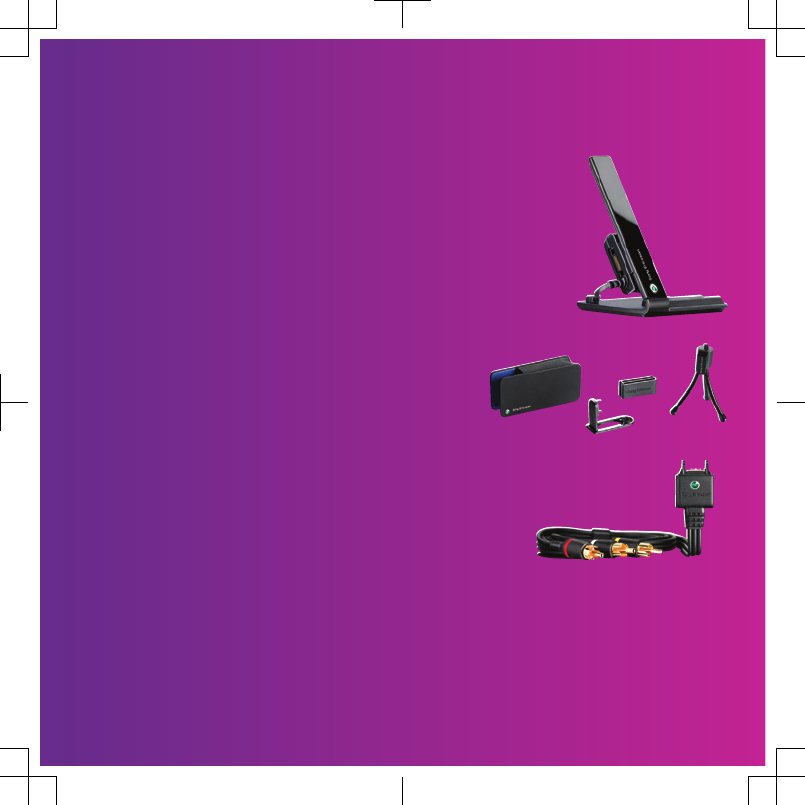
Accessories – More for your phone
Desk Stand CDS-75
Charge your phone and transfer files to your
computer simultaneously
Camera Phone Kit IPK-100
Never miss a shot with a protective
case, tripod and belt clip
TV-Out Cable ITC-60
Share your images on the big screen
These accessories can be purchased separately but may not be available in every
market. To view the full range go to www.sonyericsson.com/accessories.

Contents
Getting started......................6
Assembly............................................6
Turning on the phone.........................7
Help....................................................8
Charging the battery..........................8
Phone overview................................11
Menu overview.................................13
Navigation........................................15
Memory............................................16
Phone language...............................17
Entering text.....................................18
Chinese input...................................18
Cyber-shot™ ......................24
Using the camera.............................24
More camera features......................25
Viewing and tagging photos............27
Working with photos........................28
Printing photos.................................29
Transferring and
handling content.................29
Handling content in the phone.........29
Sending content to another
phone...............................................30
Transferring content to and from
a computer.......................................30
Using the USB cable........................31
Phone name.....................................32
Using Bluetooth™ wireless
technology........................................32
Backing up and restoring.................33
Calling..................................35
Making and receiving calls...............35
Contacts...........................................37
Speed dial........................................40
More calling features........................40
Messaging...........................44
Text and picture messages..............44
Voice messages...............................46
Email.................................................46
Instant messaging ...........................47
Music ..................................49
Stereo portable handsfree...............49
Music player.....................................50
1

PlayNow™........................................51
TrackID™.........................................51
Online music and video clips...........51
Video player.....................................52
Radio................................................52
MusicDJ™........................................52
Record sound...................................53
Internet................................53
Bookmarks.......................................53
History pages...................................54
More browser features.....................54
Internet security and certificates......55
Web feeds........................................55
GPS.....................................57
Using GPS........................................57
More GPS features...........................57
Synchronising.....................58
Synchronising using a computer.....58
Synchronising using an Internet
service..............................................59
More features......................60
Flight mode......................................60
Update service.................................60
Alarms..............................................61
Calendar...........................................62
Notes................................................62
Tasks................................................63
Profiles.............................................63
Time and date..................................64
Theme..............................................64
Main menu layout.............................64
Ringtones.........................................64
Screen orientation............................65
Games..............................................65
Applications.....................................65
Locks................................................66
Troubleshooting..................68
Common questions..........................68
Error messages................................70
Important information.........72
Index....................................80
2

Sony Ericsson C905c Cyber-shot™
GSM/GPRS/EDGE 850/900/1800/1900
This User guide is published by Sony Ericsson
Mobile Communications AB or its local affiliated
company, without any warranty. Improvements and
changes to this User guide necessitated by
typographical errors, inaccuracies of current
information, or improvements to programs and/or
equipment, may be made by Sony Ericsson Mobile
Communications AB at any time and without notice.
Such changes will, however, be incorporated into
new editions of this User guide.
All rights reserved.
©Sony Ericsson Mobile Communications AB, 2008
Publication number: 1216-7662.1
Please note:
Some of the services in this User guide are not
supported by all networks. This also applies to the
GSM International Emergency Number 112.
Please contact your network operator or service
provider if you are in doubt whether you can use a
particular service or not.
Please read the Important information before you
use your mobile phone.
Your mobile phone has the capability to download,
store and forward additional content, e.g. ringtones.
The use of such content may be restricted or
prohibited by rights of third parties, including but not
limited to restriction under applicable copyright
laws. You, and not Sony Ericsson, are entirely
responsible for additional content that you
download to or forward from your mobile phone.
Prior to your use of any additional content, please
verify that your intended use is properly licensed or
is otherwise authorized. Sony Ericsson does not
guarantee the accuracy, integrity or quality of any
additional content or any other third party content.
Under no circumstances will Sony Ericsson be liable
in any way for your improper use of additional
content or other third party content.
Smart-Fit Rendering is a trademark or a registered
trademark of ACCESS Co., Ltd.
Bluetooth is a trademark or a registered trademark
of Bluetooth SIG Inc. and any use of such mark by
Sony Ericsson is under license.
The Liquid Identity logo, BestPic, PlayNow,
MusicDJ, PhotoDJ, TrackID and VideoDJ are
trademarks or registered trademarks of
Sony Ericsson Mobile Communications AB.
TrackID™ is powered by Gracenote Mobile
MusicID™. Gracenote and Gracenote Mobile
MusicID are trademarks or registered trademarks of
Gracenote, Inc.
Cyber-shot is a trademark or registered trademark
of Sony Corporation.
Lotus Notes is a trademark or a registered trademark
of International Business Machines Corporation.
Sony, Memory Stick Micro™ and M2™ are
trademarks or registered trademarks of Sony
Corporation.
SyncML is a trademark or registered trademark of
Open Mobile Alliance LTD.
Ericsson is a trademark or registered trademark of
Telefonaktiebolaget LM Ericsson.
Adobe Photoshop Album Starter Edition is a
trademark or registered trademark of Adobe
Systems Incorporated in the United States and/or
other countries/regions.
Microsoft, ActiveSync, Windows, Outlook, and Vista
are registered trademarks or trademarks of
Microsoft Corporation in the United States and/or
other countries/regions.
T9™ Text Input is a trademark or a registered
trademark of Tegic Communications. T9™ Text
Input is licensed under one or more of the following:
U.S. Pat. Nos. 5,818,437, 5,953,541, 5,187,480,
5,945,928, and 6,011,554; Canadian Pat. No.
1,331,057, United Kingdom Pat. No. 2238414B;
Hong Kong Standard Pat. No. HK0940329; Republic
of Singapore Pat. No. 51383; Euro.Pat. No. 0 842
3

463(96927260.8) DE/DK, FI, FR, IT, NL, PT, ES, SE,
GB; and additional patents are pending worldwide.
This product is protected by certain intellectual
property rights of Microsoft. Use or distribution of
such technology outside of this product is prohibited
without a license from Microsoft.
Content owners use Windows Media digital rights
management technology (WMDRM) to protect their
intellectual property, including copyrights. This
device uses WMDRM software to access WMDRM-
protected content. If the WMDRM software fails to
protect the content, content owners may ask
Microsoft to revoke the software's ability to use
WMDRM to play or copy protected content.
Revocation does not affect unprotected content.
When you download licenses for protected content,
you agree that Microsoft may include a revocation
list with the licenses. Content owners may require
you to upgrade WMDRM to access their content. If
you decline an upgrade, you will not be able to
access content that requires the upgrade.
Java and all Java based trademarks and logos are
trademarks or registered trademarks of Sun
Microsystems, Inc. in the U.S. and other countries/
regions.
End-user license agreement for Sun™ Java™
J2ME™.
This product is licensed under the MPEG-4 visual
and AVC patent portfolio licenses for the personal
and non-commercial use of a consumer for (i)
encoding video in compliance with the MPEG-4
visual standard ("MPEG-4 video") or the AVC
standard ("AVC video") and/or (ii) decoding MPEG-
4 or AVC video that was encoded by a consumer
engaged in a personal and non-commercial activity
and/or was obtained from a video provider licensed
by MPEG LA to provide MPEG-4 and/or AVC video.
No license is granted or shall be implied for any other
use. Additional information including that relating to
promotional, internal and commercial uses and
licensing may be obtained from MPEG LA, L.L.C.
See http://www.mpegla.com. MPEG Layer-3 audio
decoding technology licensed from Fraunhofer IIS
and Thomson.
Restrictions: Software is confidential copyrighted
information of Sun and title to all copies is retained
by Sun and/or its licensors. Customer shall not
modify, decompile, disassemble, decrypt, extract,
or otherwise reverse engineer Software. Software
may not be leased, assigned, or sublicensed, in
whole or in part.
Export Regulations: This product, including any
software or technical data contained in or
accompanying the product, may be subject to U.S.
export control laws, including the U.S. Export
Administration Act and its associated regulations
and the U.S. sanctions programs administered by
the U.S. Treasury Department's Office of Foreign
Assets Control, and may be additionally subject to
export or import regulations in other countries/
regions. The user and any possessor of the product
agrees to comply strictly with all such regulations
and acknowledges that it is their responsibility to
obtain any required licenses to export, re-export, or
import this product. Without limitation this product,
including any software contained therein, may not
be downloaded, or otherwise exported or re-
exported (i) into, or to a national or resident of, or an
entity in, Cuba, Iraq, Iran, North Korea, Sudan, Syria
(as such listing may be revised from time to time) or
any country/region to which the U.S. has
embargoed goods; or (ii) to any person or entity on
the U.S. Treasury Department's list of Specially
Designated Nationals or (iii) any person or entity on
any other export prohibition list that may be
maintained from time to time by the United States
Government, including but not limited to the U.S.
Commerce Department's Denied Persons List or
Entity List, or the U.S. State Department's
Nonproliferation Sanctions List.
Restricted Rights: Use, duplication or disclosure by
the United States government is subject to the
restrictions as set forth in the Rights in Technical
4
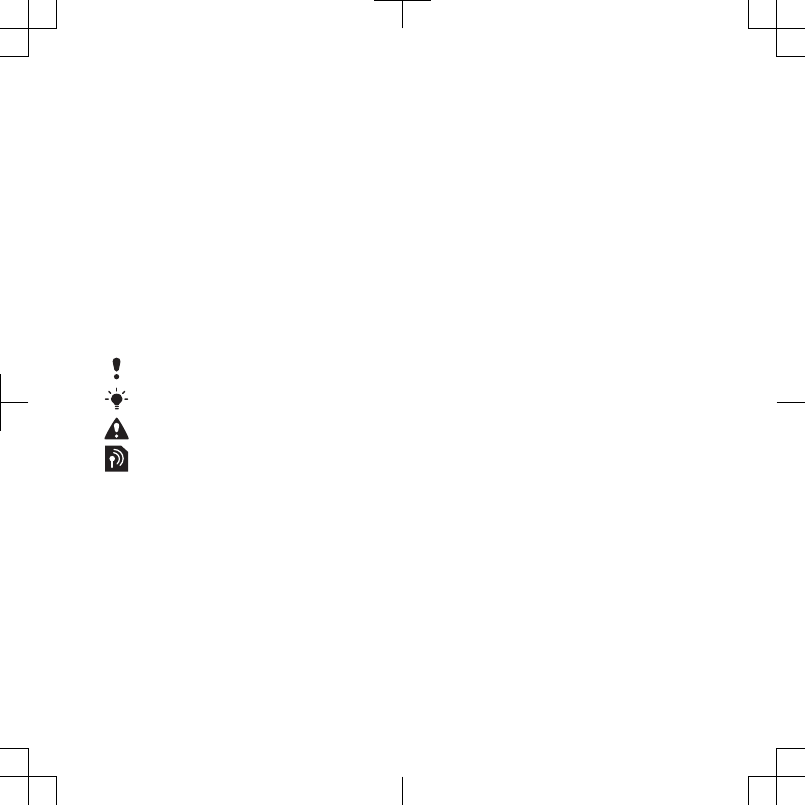
Data and Computer Software Clauses in DFARS
252.227-7013(c) (1) (ii) and FAR 52.227-19(c) (2) as
applicable.
Other product and company names mentioned
herein may be the trademarks of their respective
owners.
Any rights not expressly granted herein are reserved.
Note: Sony Ericsson advises users to backup their
personal data information.
All illustrations are for illustration only and may not
accurately depict the actual phone.
Instruction symbols
These symbols may appear in the User
guide.
Note
Tip
Warning
A service or function is network- or
subscription-dependent. Contact
your network operator for details.
> Use a selection or navigation key
to scroll and select. See
Navigation on page 15.
5
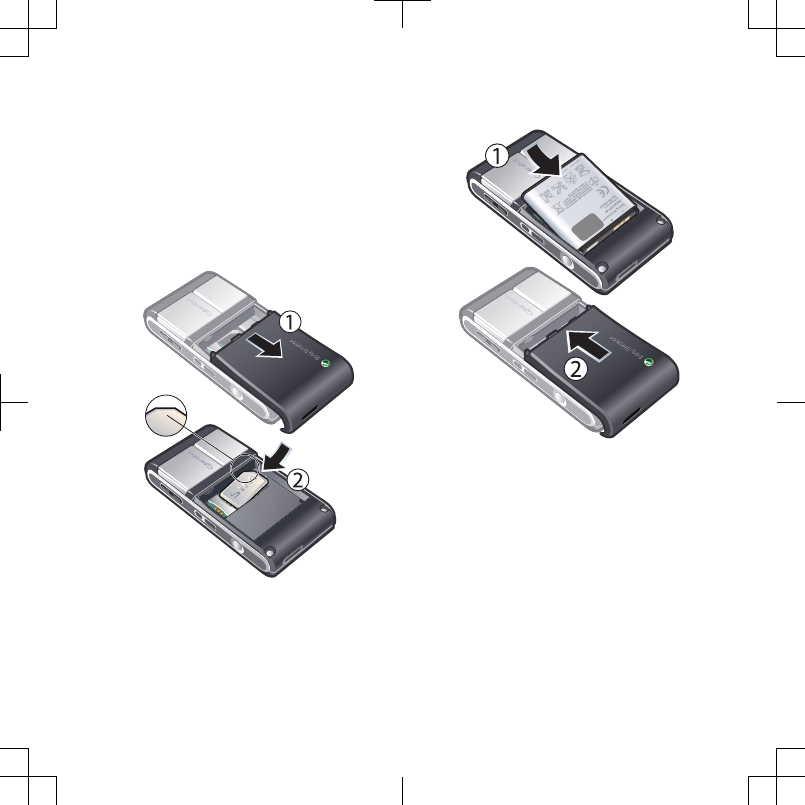
Getting started
Assembly
Before you start using your phone, you
need to insert a SIM card and the
battery.
To insert the SIM card
1Remove the battery cover.
2Slide the SIM card into its holder with
the gold-coloured contacts facing
down.
To insert the battery
1Insert the battery with the label side up
and the connectors facing each other.
2Slide the battery cover into place.
6Getting started
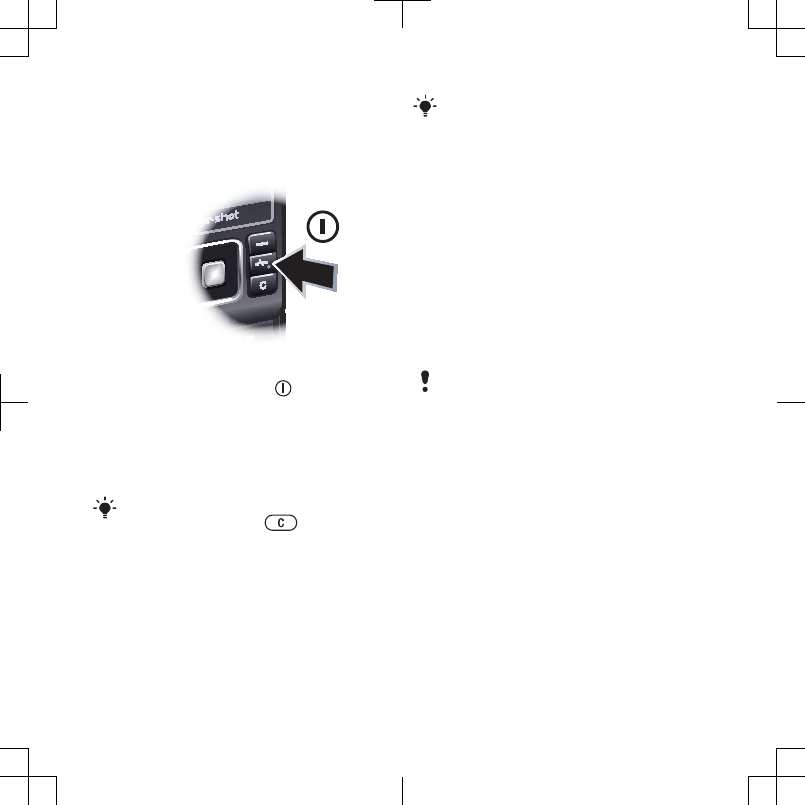
Turning on the phone
To turn on the phone
1Press and hold down .
2Enter your SIM card PIN, if requested,
and select OK.
3Select a language.
4Select Continue to use the setup
wizard.
If you want to correct a mistake when you
enter your PIN, press .
SIM card
The SIM (Subscriber Identity Module)
card, which you get from your network
operator, contains information about
your subscription. Always turn off your
phone and detach the charger before
you insert or remove the SIM card.
You can save contacts on the SIM card
before you remove it from your phone.
See To copy names and numbers to the
SIM card on page 38.
PIN
You may need a PIN (Personal
Identification Number) to activate the
services and functions in your phone.
Your PIN is supplied by your network
operator. Each PIN digit appears as *,
unless it starts with emergency number
digits, for example, 112 or 911. You can
see and call an emergency number
without entering a PIN.
If you enter the wrong PIN three times in
a row, the SIM card is blocked. See SIM
card lock on page 66.
Standby
After you have turned on your phone
and entered your PIN, the name of the
network operator appears. This view is
called standby. Your phone is now
ready for use.
Using other networks
Making and receiving calls, using
messaging, and data transfer, for
example, Internet-based services,
outside your home network (roaming),
Getting started 7
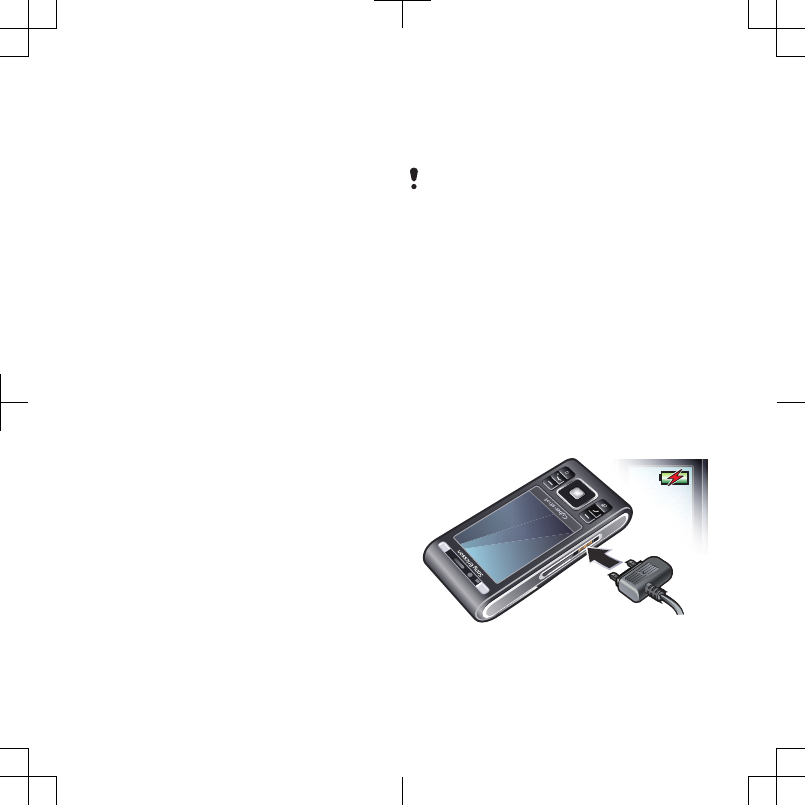
may incur additional costs. Contact
your operator for more information.
Help
In addition to this User guide, Feature
guides and more information are
available at
www.sonyericsson.com/cn.
Help and information are also available
in your phone.
To view tips and tricks
1From standby select Menu > Settings >
the General tab > Setup wizard.
2Select Tips and tricks.
To view information about functions
•Scroll to a function and select Info, if
available. In some cases, Info appears
under Options.
To view the phone demonstration
•From standby select Menu >
Entertainment > Demo tour.
To view the phone status
•From standby press the volume key.
Phone, memory and battery
information is shown.
Charging the battery
The phone battery is partly charged
when you buy it.
It may take 30 minutes for the battery icon
to appear on the screen.
Using the USB charger
To connect the charger and charge
the battery
(The illustrations are for guidance only
and may not accurately depict the
actual phone)
1Connect the USB cable (you can get
instructions for three conditions from
the Note) plug to the AC adapter USB
socket, as shown in the illustration. The
USB cable is supplied with your phone.
2Connect the USB cable connector to
your phone. Press a key to view the
charging status on the screen. It takes
8Getting started
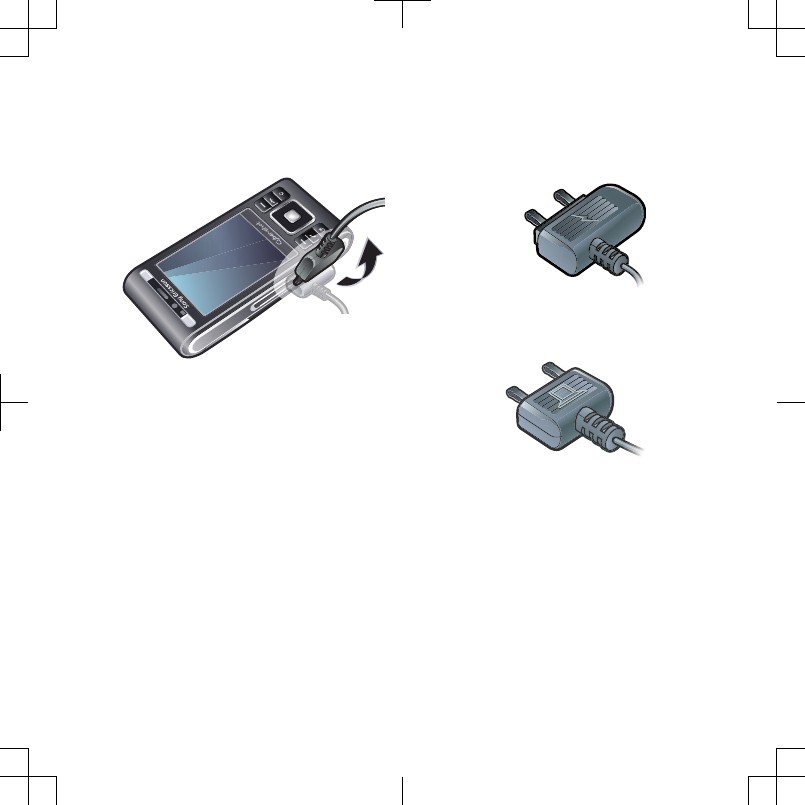
approximately 2.5 hours to fully charge
the battery.
To remove the charger
1Charge your battery until the battery
icon indicates a full charge.
2Tilt the USB charger connector
upwards to remove it.
Note
•If there are two USB cables in the kit
(USB cable for charging and USB
cable for data transferring, see the
illustrations below), then the USB
cable for charging is only intended
for charging your phone. Do not use
it for transferring data. The USB
cable for the USB charger is only
intended for connection to the AC
adapter to charge your phone. It
must not be used for connection to
a PC. It can only be used for
charging your phone. Never use it
for charging accessories.
USB cable for charging
USB cable for transferring
•If there is only one USB cable in the
kit, it is intended for charging your
phone as well as transferring data.
•If there is only one USB cable for the
USB charger in the phone kit, this
USB cable is only intended for
charging your phone.
•Sony Ericsson strongly recommends
that you use only Sony Ericsson
branded original batteries, the part
Getting started 9
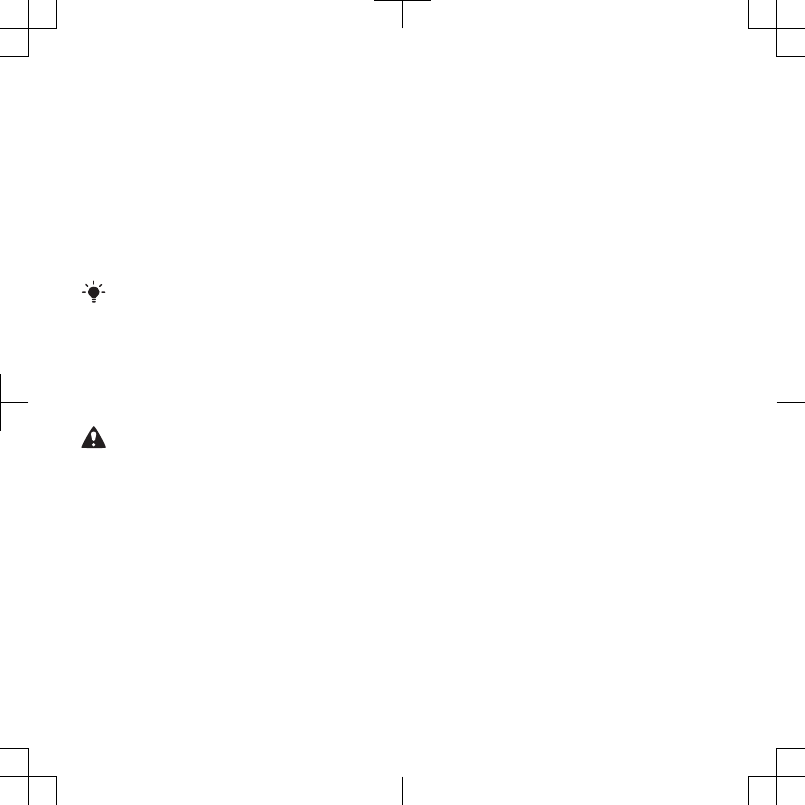
of power supply device in
accordance with YD/T 1591-2006
specifications of Communications
Industry Standards of P. R. China
and the USB cable supplied with
your phone to charge the phone.
The use of third-party products may
decrease the performance of your
phone and/or pose a risk to your
health or safety
You can charge the battery for more or
less than 2.5 hours. Interrupted charging
will not damage the battery. Performance
depends on temperatures, signal
strength, usage patterns, features
selected and voice or data transmissions.
The standby time for this battery is up to
380 hours.
Use only Sony Ericsson branded original
batteries intended for use with your
mobile phone. If you use other batteries
you may not be able to charge your
phone.
10 Getting started
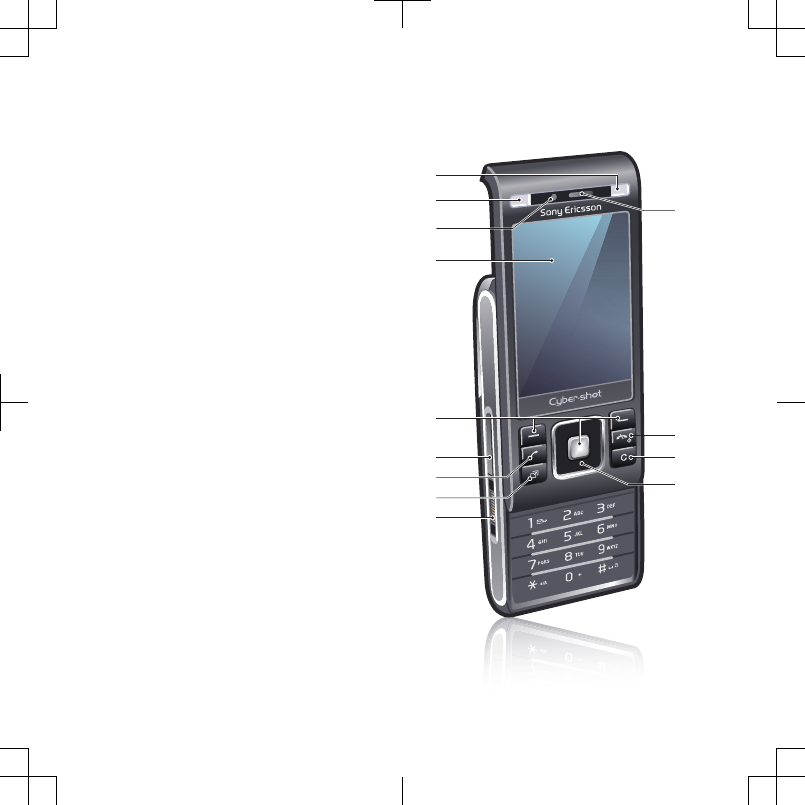
Phone overview
1 Photo key, gaming key B
11
12
4
5
9
6
7
3
8
13
10
1
2
2 Photo key, gaming key A
3 Light sensor
4 Screen
5 Selection keys
6 Memory card slot
7 Call key
8 Activity menu key
9 Connector for charger, handsfree
and USB cable
10 Ear speaker
11 End, on/off key
12 C key (Clear)
13 Navigation key
Getting started 11
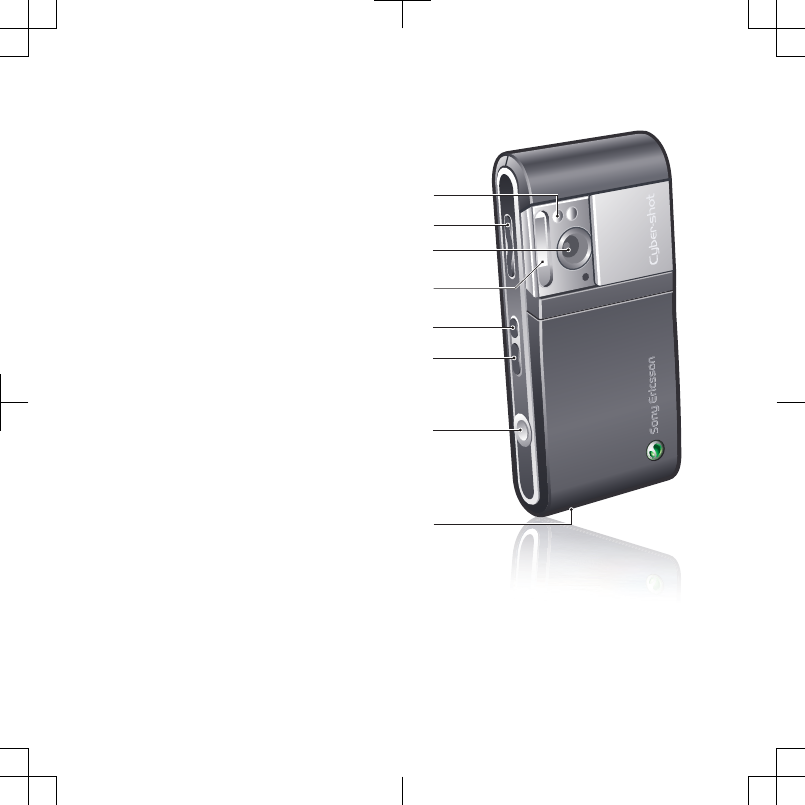
14 Self-portrait mirror
15 Volume, digital zoom keys
19
18
16
20
15
14
17
21
16 Camera lens
17 Flash
18 Camera view key
19 Camera mode key
20 Camera key
21 Strap holder
12 Getting started
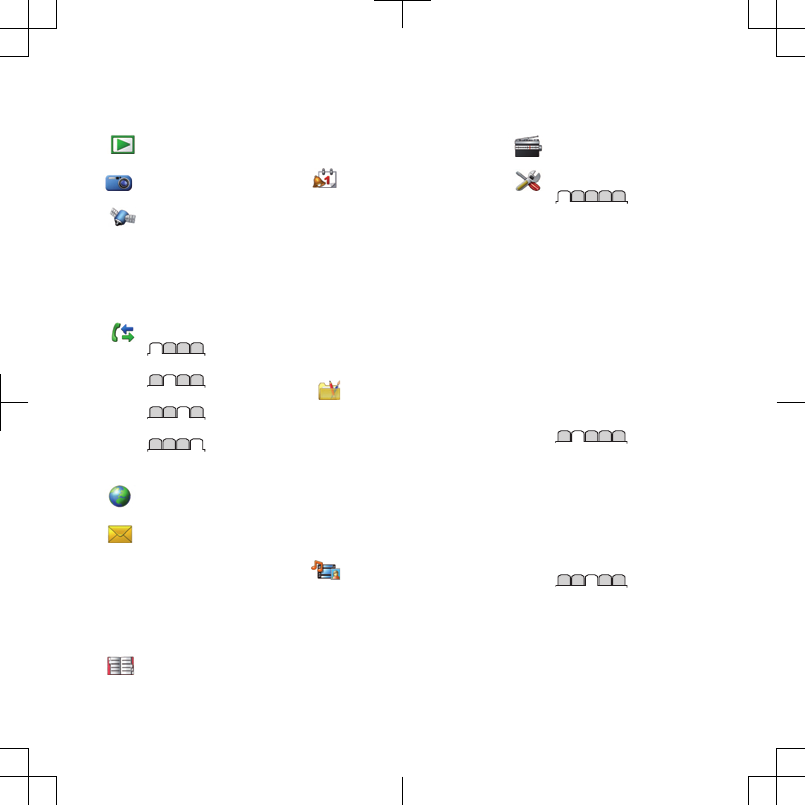
Menu overview
PlayNow™*
Cyber-shot™
Location services
Navigation*
My favourites
Status info
Log
Settings
Calls**
All
Answered
Dialled
Missed
Monternet
Messaging
Write new
Inbox
Messages
Email
IM*
Call voicemail
Contacts
Myself
New contact
Organiser
File manager **
Alarms
Applications
Calendar
Tasks
Notes
Synchronisation
Timer
Stopwatch
Calculator
Code memo
Entertainment
Online services*
TrackID™
Games
VideoDJ™
PhotoDJ™
MusicDJ™
Remote control
Record sound
Demo tour
Media
Photo
Music
Video
Games
Web feeds
Settings
Radio
Settings**
General
Profiles
Time & date
Language
Update service
Voice control
New events
Shortcuts
Flight mode
Security
Setup wizard
Accessibility*
Phone status
Master reset
Sounds & alerts
Ring volume
Ringtone
Silent mode
Increasing ring
Vibrating alert
Message alert
Key sound
Display
Wallpaper
Main menu layout
Theme
Startup screen
Screen saver
Getting started 13

Clock size
Brightness
Edit line names*
Calls
Speed dial
Smart search
Divert calls
Switch to line 2*
Manage calls
Time & cost*
Show/hide my no.
Handsfree
Open to answer
Close to end call
Connectivity
Bluetooth
USB
Phone name
Network sharing
Synchronisation
Device management
Mobile networks
Data communication*
Internet settings
Streaming settings
Message settings*
SIP settings
Accessories
* Some menus are operator-,
network- and subscription-
dependent.
** You can use the navigation
key to scroll between tabs in
submenus. For more
information, see Navigation
on page 15.
14 Getting started
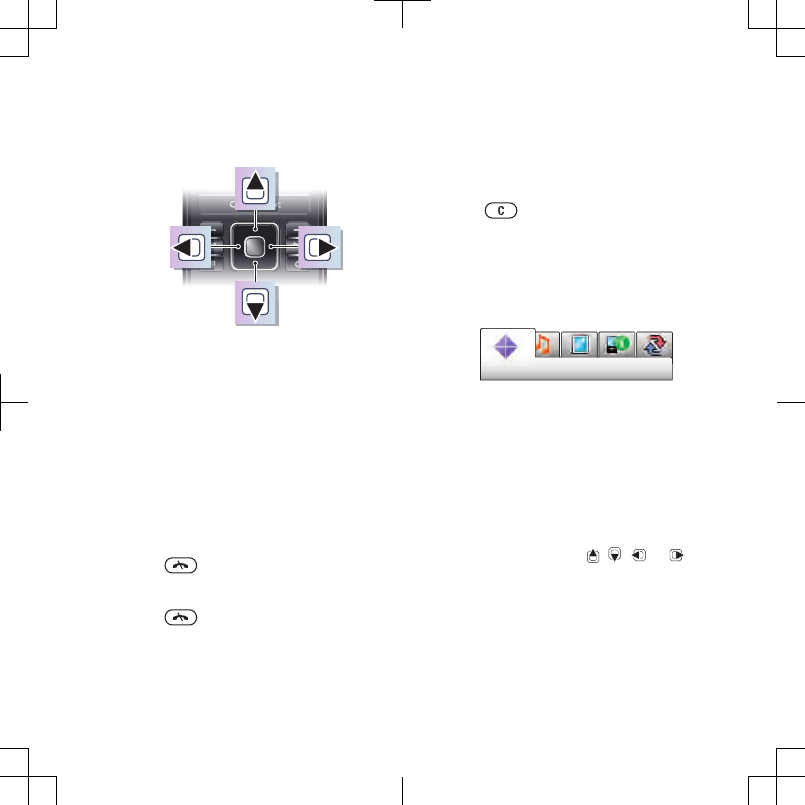
Navigation
To navigate the phone menus
1From standby select Menu.
2Use the navigation key to move
through the menus.
To select actions on the screen
•Press the left, centre or right selection
key.
To view options for an item
•Select Options to, for example, edit.
To end a function
•Press .
To return to standby
•Press .
To navigate your media
1From standby select Menu > Media.
2Scroll to a menu item and press the
navigation key right.
3To go back, press the navigation key
left.
To delete items
•Press to delete items such as
numbers, letters, pictures and sounds.
Tabs
Tabs may be available. For example,
Settings have tabs.
To scroll between tabs
•Press the navigation key left or right.
Shortcuts
You can use keypad shortcuts to go
directly to functions.
To use navigation key shortcuts
•From standby press , , or to
go directly to a function.
To edit a navigation key shortcut
1From standby select Menu > Settings >
the General tab > Shortcuts.
2Scroll to an option and select Edit.
Getting started 15
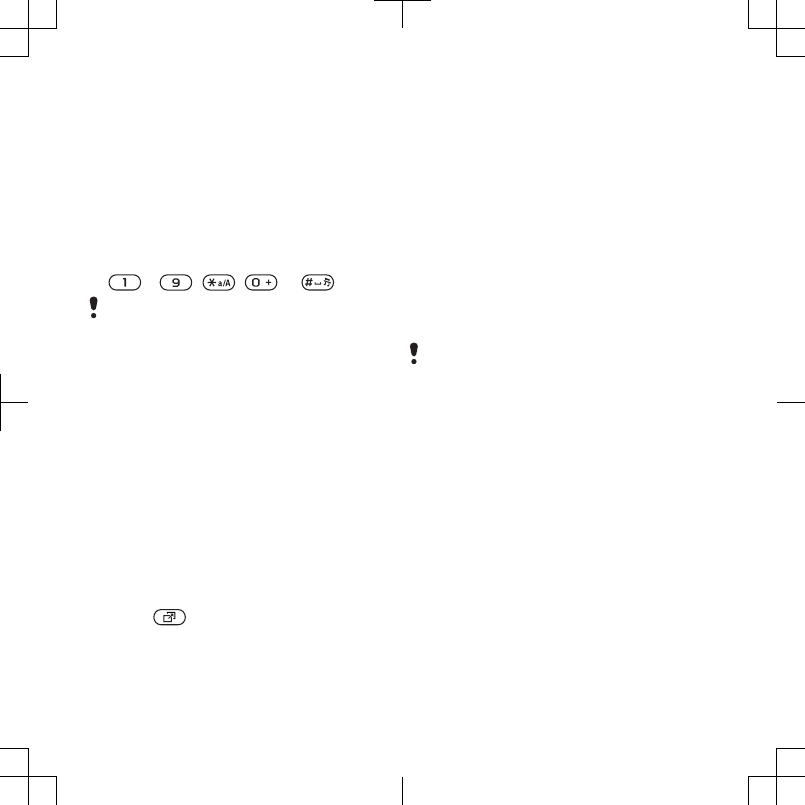
3Scroll to a menu option and select
Shortc..
Main menu shortcuts
Menu numbering starts from the top left
icon and moves across and then down
row by row.
To go directly to a main menu
•From standby select Menu and press
– , , or .
The Main menu layout must be set to
Grid. See To change the main menu
layout on page 64.
Activity menu
The activity menu gives you quick
access to:
•New events – missed calls and new
messages.
•Running apps – applications that are
running in the background.
•My shortcuts – add your favourite
functions to access them quickly.
•Internet – quick access to the
Internet.
To open the activity menu
•Press .
Memory
You can save content on the memory
card, in the phone memory and on the
SIM card. Photos and music are saved
on the memory card, if a memory card
is inserted. If not, or if the memory card
is full, photos and music are saved in
the phone memory. Messages and
contacts are saved in the phone
memory, but you can choose to save
them on the SIM card.
Memory card
You may have to purchase a memory card
separately.
Your phone supports Memory Stick
Micro™ (M2™) memory card adding
more storage space to your phone. It
can also be used as a portable memory
card with other compatible devices.
You can move content between the
memory card and the phone memory.
See Handling content in the phone on
page 29.
16 Getting started
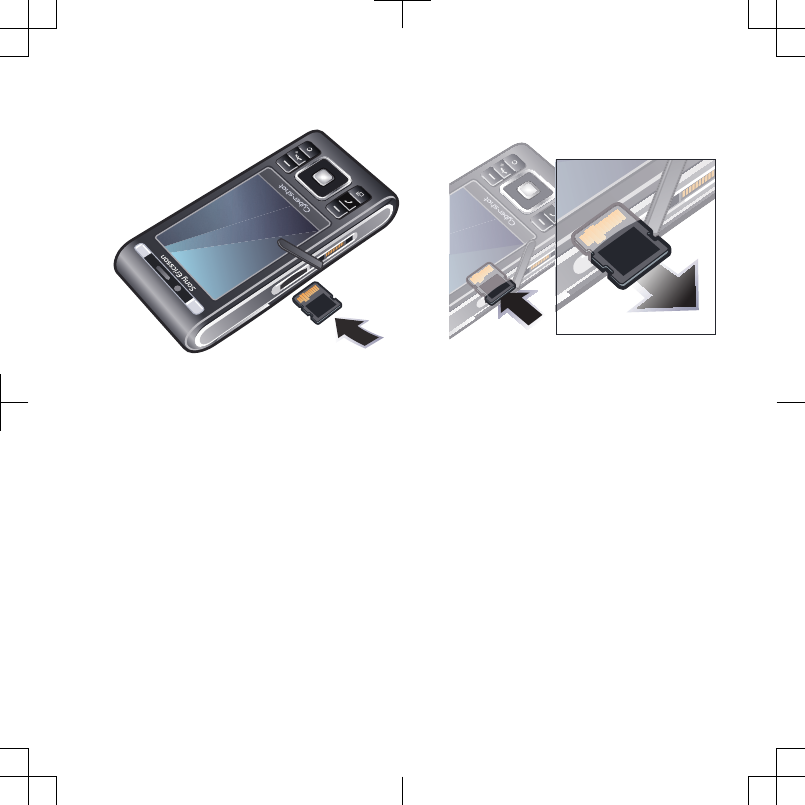
To insert a memory card
•Open the cover and insert the memory
card with the gold-coloured contacts
facing up.
To remove a memory card
•Open the cover and press the edge of
the memory card to release and
remove it.
Phone language
You can select a language to use in
your phone.
To change the phone language
1From standby select Menu > Settings >
the General tab > Language > Phone
language.
2Select an option.
Getting started 17
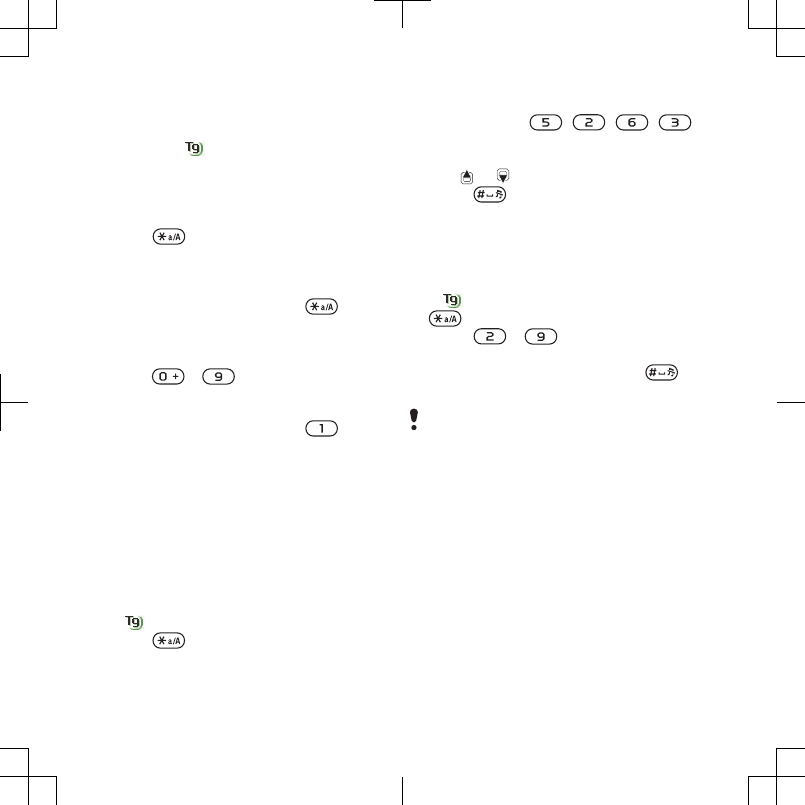
Entering text
You can use multitap text input or T9™
Text Input to enter text. The T9 Text
Input method uses a built-in dictionary.
To change text input method
•When you enter text, press and hold
down .
To shift between capitals and lower-
case letters
•When you enter text, press .
To enter numbers
•When you enter text, press and hold
down – .
To enter full stops and commas
•When you enter text, press .
To enter a symbol
1When you enter text, select Options >
Add symbol.
2Scroll to a symbol and select Insert.
To enter text using T9™ Text Input
1From standby select, for example,
Menu > Messaging > Write new >
Message.
2If is not displayed, press and hold
down to change to T9 Text Input.
3Press each key only once, even if the
letter you want is not the first letter on
the key. For example, to write the word
“Jane”, press , , , .
Write the whole word before looking at
the suggestions.
4Use or to view suggestions.
5Press to accept a suggestion.
To enter text using multitap
1From standby select, for example,
Menu > Messaging > Write new >
Message.
2If is displayed, press and hold down
to change to multitap text input.
3Press – repeatedly until the
desired letter appears.
4When a word is written, press to
add a space.
Multitap input only applies when latin
characters are selected as input
language.
To add words to the built-in dictionary
1When you enter text using T9 Text
Input, select Options > Spell word.
2Write the word using multitap input and
select Insert.
Chinese input
This mobile phone has different input
methods for entering Chinese
characters:
•Stroke input
18 Getting started
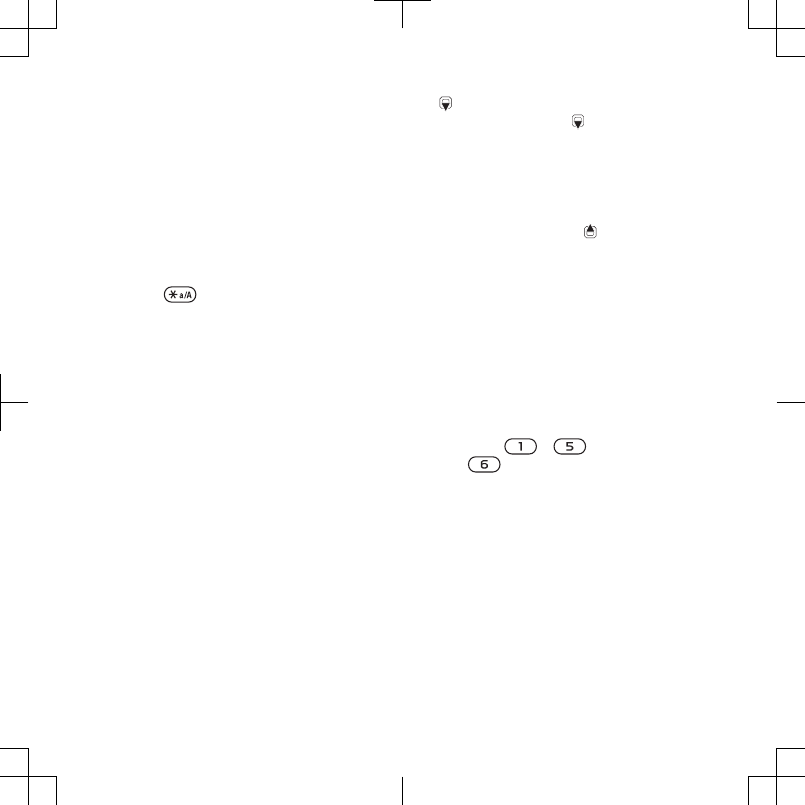
•Pinyin input
You can use these methods, for
example, to enter Chinese names and
Chinese short messages.
Switching between Chinese input
methods
In the Chinese editing mode, you can
select and switch quickly to another
input method by pressing and holding
down .
General instructions
Regardless of which input method you
choose, your phone has a function to
speed up the entry of Chinese
characters. Whenever you enter a
stroke or a Pinyin letter, a candidate
row of the most frequently used
characters containing that stroke or
relating to that letter appears at the
bottom of the screen.
If the character you want is not
displayed in the candidate row, press
to present another candidate row.
Continue pressing until the character
you want is displayed. Alternatively,
you can enter the next stroke or Pinyin
letter, and a new set of characters will
immediately be displayed in the
candidate row. To go back to the
previous row, press . To select a
character in the candidate row, press
the navigation key or press and hold
the key corresponding to the number
above the character you want to enter.
Stroke input
A Chinese character is built up of
strokes. There are more than 30 basic
strokes, which are grouped into five
stroke categories. Each category is
represented on the keypad by one of
the keys - . The Wild Card
key , is used when you are not sure
of which stroke to use.
Stroke categories
The five stroke categories are defined in the table below:
Getting started 19
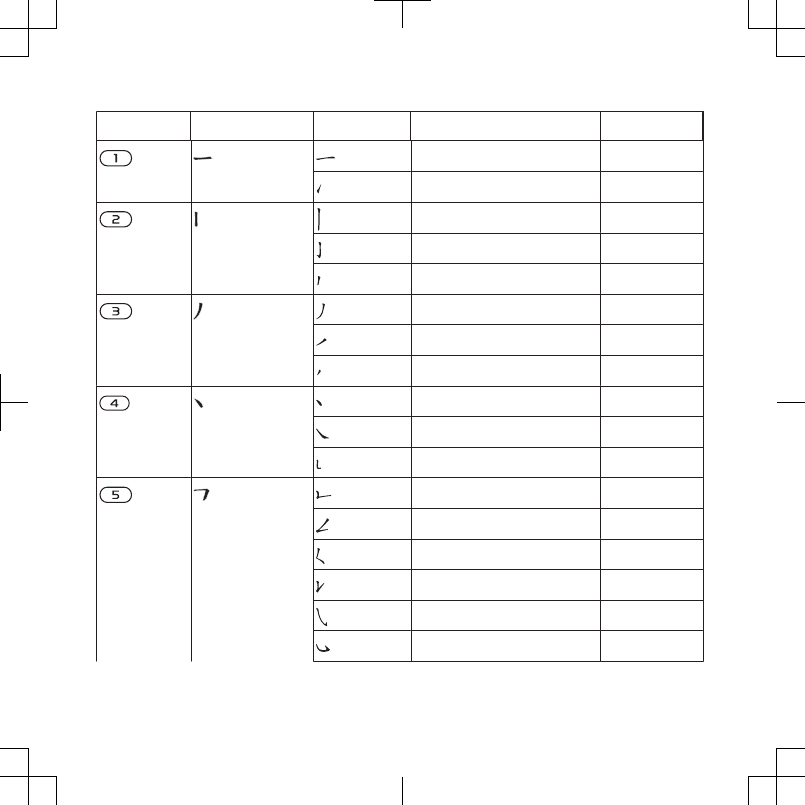
Number key Stroke category Basic stroke Stroke name Character
Over 王 十 在 七 天
Lift 海 红 牡 状 习
Down 中 业 上 门 丑
Down-Hook 小 水 打 子 承
Short Slope Down 直 真 质 草
Long Left Slope 八 九 丹 风 片
Over Slope 香 千 匕 后 丢
Short left Slope 而 页 面 学 殷
Dot 六 学 雷 心 性
Right Slope 人 火 又 送 林
Down-Curved-Over 四 西 酉 酸
Down-Over 山 巨 屯 母 凶
Left Slope-Over 么 去 公 约 能
Left Slope-Dot 女 要 好 巡 巢
Down-Lift 衣 以 饭 收 长
Right Slope-Hook 我 或 民 成 伐
Down-Over-Hook 心 必 思 忘
20 Getting started
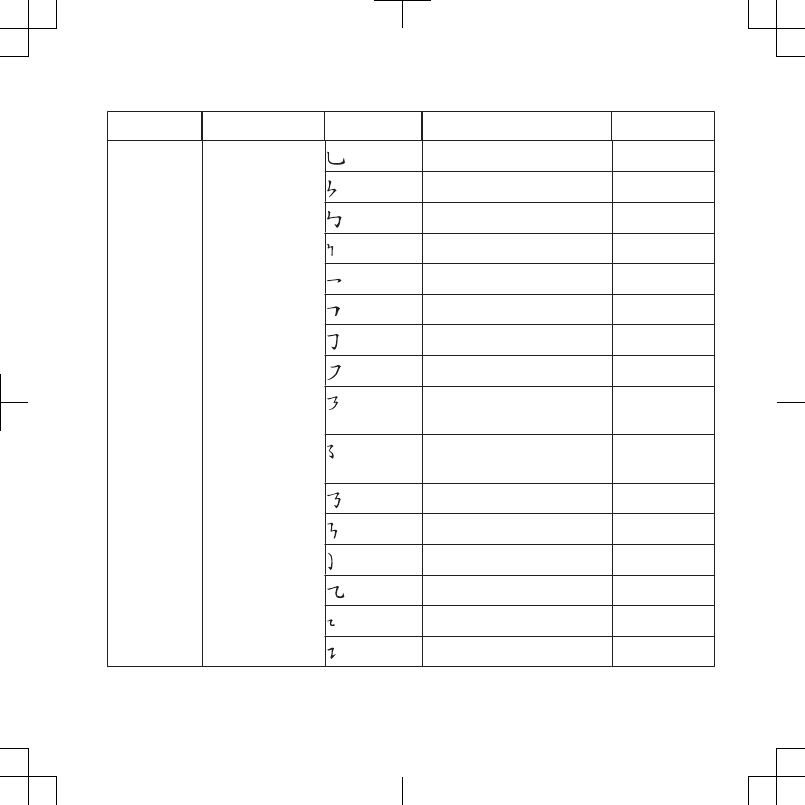
Number key Stroke category Basic stroke Stroke name Character
Down-Over-Curved-Hook 电 也 毛 兄 孔
Down-Over-Left-Slope 专 传 转
Down-Over-Down-Hook 马 与 张 号 费
Down-Over-Down 鼎 鼐
Over-Hook 写 字 皮 通 免
Over-Down 口 已 户 书 骨
Over-Down-Hook 力 习 也 同 永
Over-Left Slope 又 之 登 多 社
Over-Down-Over- Left
Slope
及 极 廷 建
Over-Left Slope- Curved-
Hook
阿 队 陈 那 部
Over-Down-Over-Hook 乃 透 鼐 隽 杨
Over-Down-Over-Down 凸
Curved-Hook 狗 豹 家 逐 狂
Over-Down-Curved-Hook 乙 九 瓦 飞 风
Over-Down-Over 投 沿 船 凹
Over-Down-Lift 话 计 认 讯
Getting started 21
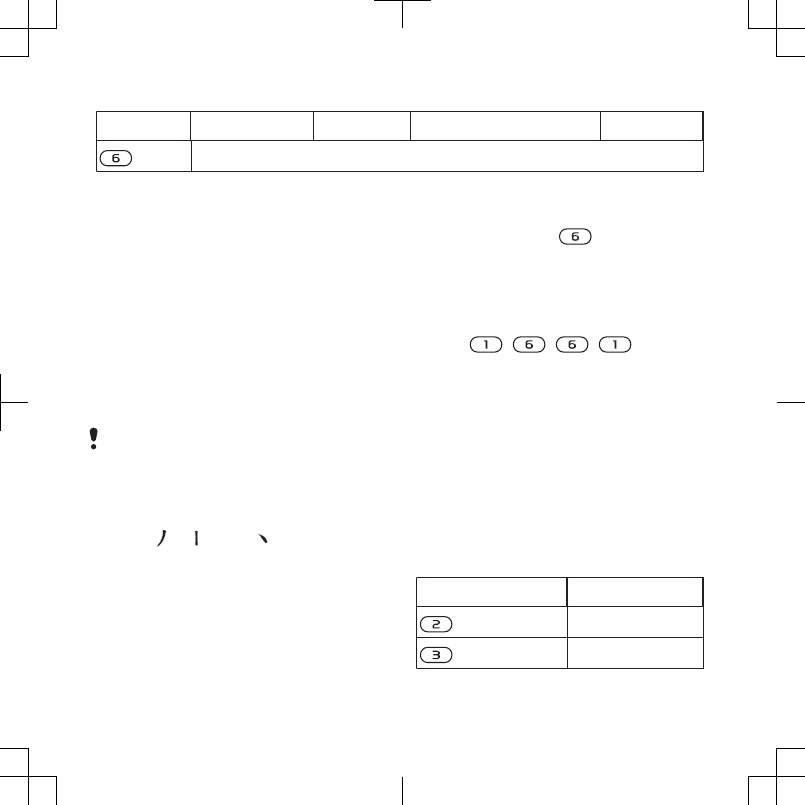
Number key Stroke category Basic stroke Stroke name Character
? (Wild card key)
Components
The basic building units of Chinese
characters are components that are
made up of strokes. After entering the
first two strokes of the desired
character, the component and
character candidates that started with
that stroke are displayed in the
candidate row.
Using components is a fast method for
entering complex characters.
The smaller candidates surrounded by
dotted frames are components, and the
bigger candidates without dotted frames
are characters.
For example, to enter “
信息”
1Enter “ ”, “ ” and “ ”.
2Move the cursor to “信”, press the
centre selection key.
3Move the cursor to “息”, press the
centre selection key again to select
“ 息”.
Example of using the wild card key
The wild card key , is used to
supplement unclear strokes in entering
characters. If you want to enter “互”,
but you only know that “ 一” is the first
and the last stroke of the character and
that the total number of strokes is four,
enter , , , . The
character is displayed in the candidate
row.
Pinyin input
Press the keys containing the required
Pinyin letters, and the phone will make
various proposals on the screen,
according to the pronunciation rules of
Mandarin.
Below is the key mapping of Pinyin
letters on the keypad.
Number Key Pinyin Letter
a b c
d e f
22 Getting started
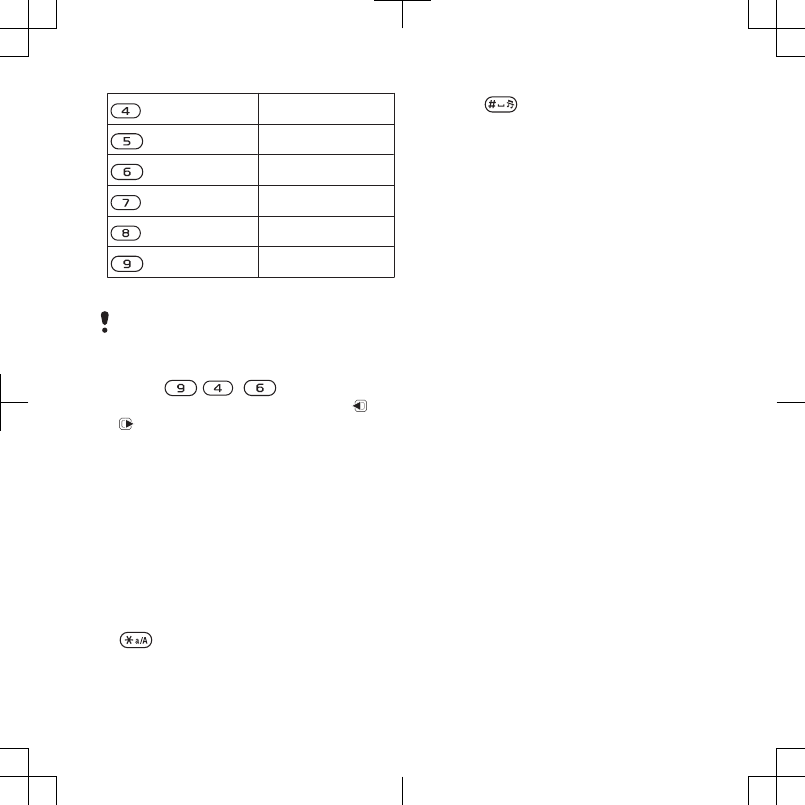
g h i
j k l
m n o
p q r s
t u ü
w x y z
On the keypad, the letter ü is replaced by
v.
For example, to enter “
信息”
1Press , , .
2When “xin” is highlighted, press or
and select “ 信”, then press the
centre selection key. (If you want to
enter any of the other suggested Pinyin
combinations, scroll up or down to the
desired combination, then press the
centre selection key.)
3Press the centre selection key again to
select “ 息”, when “ 息” is highlighted.
Input punctuation, symbols and
smilies
Under any Chinese input mode, press
, to see the table of punctuation
marks, symbols and smilies. Use the
navigation key to make a selection.
Press to enter a space into the
text.
Fuzzy Pinyin
Fuzzy Pinyin is an option for the Pinyin
input method, which contains
additional spelling alternatives.
To turn Fuzzy Pinyin on
•When you write using Pinyin input,
select Options > Writing options > Fuzzy
Pinyin.
Getting started 23
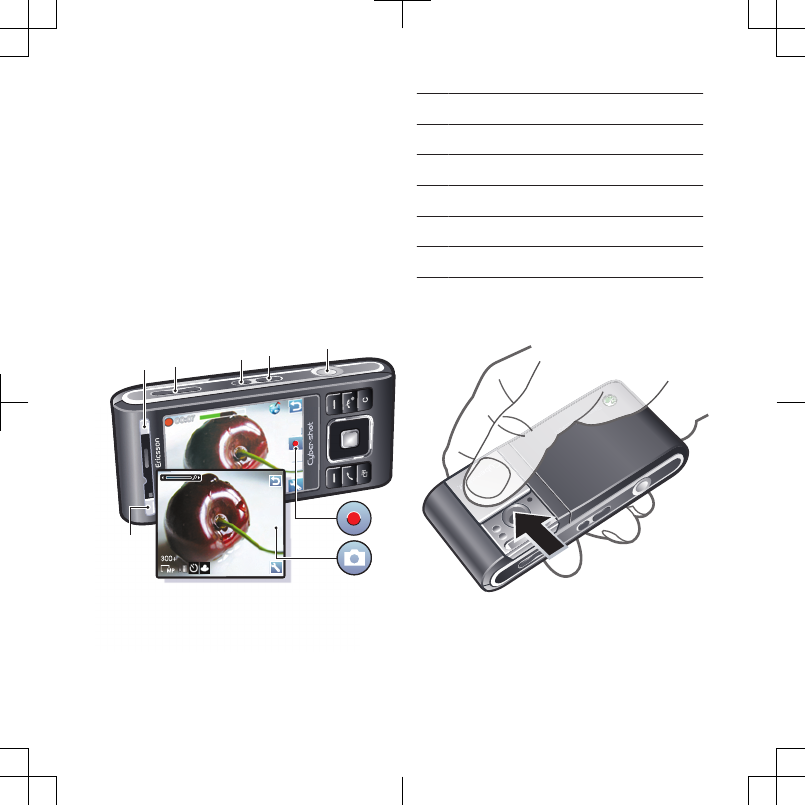
Cyber-shot™
You can take photos and record video
clips to view, save or send. You find
saved photos and video clips in Media
and in File manager.
Using the camera
Your Cyber-shot™ camera has 8.1 MP
with auto-focus, face detection and
photo flash. You can use the light when
recording videos.
4
5
6
1
2
3
1 Take photos/Record video
2 Select camera mode
3 View photos and videos
4 Zoom in or out
5 Shoot mode
6 Scenes
To activate the camera
•Open the retractable lens cover.
24 Cyber-shot™
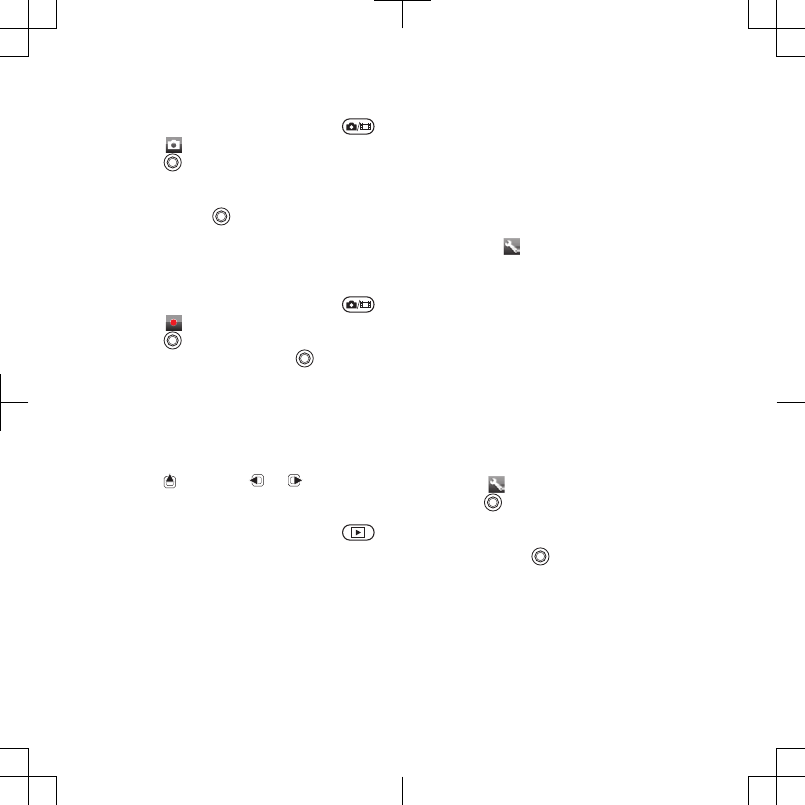
To take a photo
1Activate the camera and press to
select .
2Press halfway down to use auto
focus.
3When the dot and focus frame are
green, press fully down to take a
photo. The photo is automatically
saved.
To record a video clip
1Activate the camera and press to
select .
2Press fully down to start recording.
3To stop recording, press fully down.
The video clip is automatically saved.
To use zoom
•Press the volume key up or down.
To adjust brightness
•Press and then or .
To view photos and video clips
1Activate the camera and press .
2Scroll to the item.
3To view a video clip, press the centre
selection key.
Face detection
You can use face detection to bring an
off-centre face into focus. The camera
automatically detects up to three faces,
indicated by white frames. A green
frame shows which face has been
selected when auto-focus is used.
Focus is set to the face closest to the
camera.
To set face detection
•From standby select Menu > Cyber-
shot™ > > Focus > Face detection.
More camera features
BestPic™ helps you capture the
precise moment. The light works
automatically with BestPic™ when
light conditions are poor. Use Photo
mate to learn about camera functions.
You can improve an underexposed
photo with Photo fix.
To use BestPic™
1Activate the camera.
2Select > Shoot mode > BestPic™.
3Press halfway down to use auto
focus.
4When the dot and focus frame are
green, press fully down to complete
the shot.
5Select Options > Save all or press the
navigation key left or right to choose
the best photo and select Save.
Cyber-shot™ 25
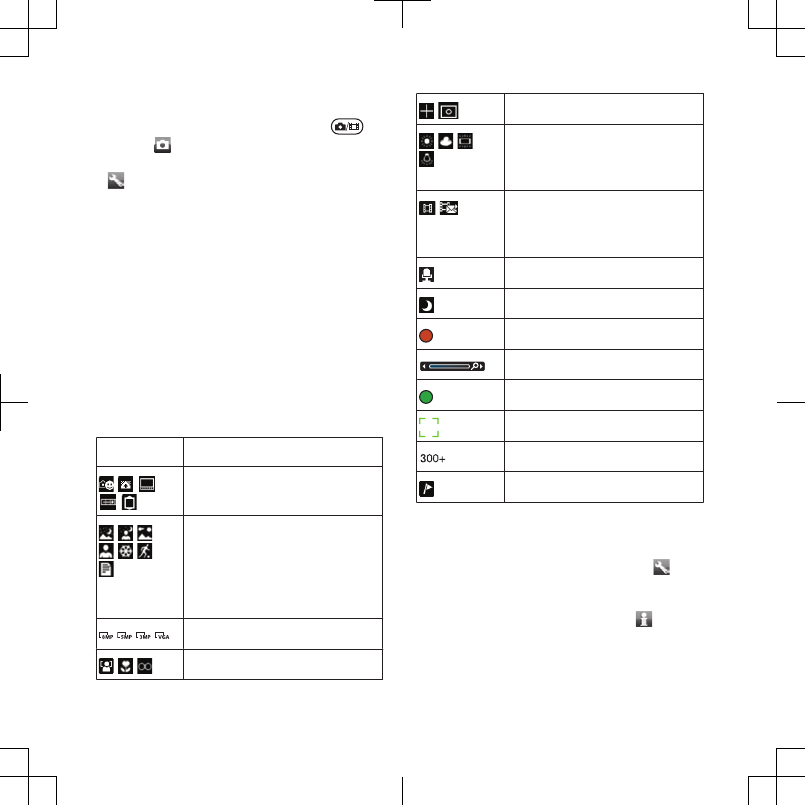
To improve a photo with Photo fix
1Activate the camera and press to
select .
2Make sure Review is set to On. Select
> Settings and scroll to Review >
On.
3Take a photo.
4During review, select Options > Photo
fix.
To use Photo Mate
•From standby select Menu > Organiser
> Applications > Photo Mate.
Camera icons and settings
Icons on the screen inform what the
current setting is. More camera
settings are available in Settings.
Icon Description
Shoot mode
Scenes. Predefined
settings for common photo
situations, including
landscape, portrait and
sport
Picture size
Focus/Face detection
Metering mode
White balance. To adjust
colour tones to the lighting
conditions
Video length. For picture
messages, the length is
limited
Microphone
Night mode
Video: recording
Zoom
Auto focus
Focus frame
Camera: remaining photos
Geo tagging is turned on
To change settings
•Activate the camera and select .
To view information about settings
•Scroll to a setting and select .
26 Cyber-shot™

Viewing and tagging photos
You can view and tag your photos in
Media.
To view photos in a slide show
1From standby select Menu > Media >
Photo > Camera album.
2Select a month.
3Scroll to a photo and select View.
4Select Options > Slide show.
5Select a mood.
Viewing photos on a map
When appears on the screen, your
geographical position is saved with the
photos you take. This is called geo
tagging, and it shows the approximate
location of where a photo was taken.
To view photos on a map
1From standby select Menu > Media >
Photo > Camera album.
2Select a month.
3Scroll to a photo and select View.
4Select Options > View on map.
To change the geo tagging setting
1From standby select Menu > Camera >
> Settings > Add position.
2Select an option.
Photo tags
You can tag photos to categorise them
in Photo tags. For example, you can
create a tag called vacation and add it
to all your vacation photos.
To create a new photo tag
1From standby select Menu > Media >
Photo > Camera album.
2Select a month.
3Scroll to a photo and select View.
4Press and select Options > New tag.
5Enter a name and select OK.
6Select an icon.
7To tag the photo, select Options > Tag
this photo.
To tag photos
1From standby select Menu > Media >
Photo > Camera album.
2Select a month.
3Scroll to a photo and select View.
4Press and scroll to a tag.
5Select Options > Tag this photo.
6For each photo you want to tag, scroll
to the photo and select Options > Tag
this photo.
Using photos
You can add a photo to a contact, use
it during phone startup, as a wallpaper
in standby or as a screen saver.
Cyber-shot™ 27

To use photos
1From standby select Menu > Media >
Photo > Camera album.
2Select a month.
3Scroll to a photo and select View.
4Select Options > Use as.
5Select an option.
To set a Java™ application as a
wallpaper
1From standby select Menu > Settings >
the Display tab.
2Select Wallpaper > Application.
3Select a Java application.
You can only see the Java applications
that have support for wallpaper.
Working with photos
You can view, enhance and organise
your photos and video clips on your
computer by installing the Adobe™
Photoshop™ Album Starter Edition. It
is included on the CD that comes with
your phone and available for download
at www.sonyericsson.com/support.
Use Sony Ericsson Media Manager to
transfer content to and from your
phone. For more information, see
Transferring content to and from a
computer on page 30.
PhotoDJ™ and VideoDJ™
You can edit photos and video clips.
To edit and save a photo
1From standby select Menu > Media >
Photo > Camera album.
2Select a month.
3Scroll to a photo and select View.
4Select Options > Edit in PhotoDJ™.
5Edit the photo.
6Select Options > Save picture.
To edit and save a video clip
1From standby select Menu > Organiser
> File manager > Videos.
2Scroll to a video clip and select
Options > Edit in VideoDJ™.
3Edit the video clip.
4Select Options > Save.
To trim a video clip
1From standby select Menu > Organiser
> File manager > Videos.
2Scroll to a video clip and select
Options > Edit in VideoDJ™ > Edit >
Trim.
3Select OK > Set > Start to set the
starting point.
4Select Set > End to set the ending
point.
5Select Trim > Options > Save.
28 Cyber-shot™
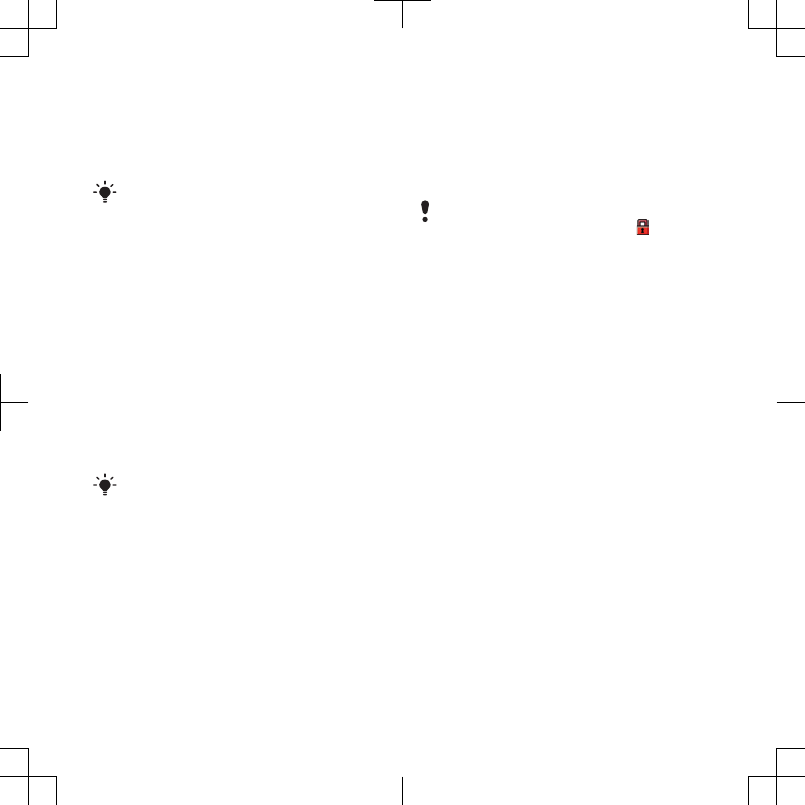
Printing photos
You can print photos using the USB
cable connected to a compatible
printer.
You can also print using a Bluetooth
compatible printer that supports the
Object Push Profile.
To print photos using the USB cable
1Connect the USB cable to the phone.
2Connect the USB cable to the printer.
3Wait for feedback in the phone and
select OK.
4Enter printer settings (if required) and
select Print.
5From standby select Menu > Media >
Photo > Camera album.
6Select a month.
7Scroll to a photo and select Options >
Print.
You should disconnect and re-connect
the USB cable if there is a printer error.
Transferring and
handling content
You can transfer and handle content
such as pictures and music.
You are not allowed to exchange some
copyright-protected material. identifies
a protected item.
Handling content in the phone
You can use File manager to handle
content saved in the phone memory or
on a memory card. Tabs and icons in
File manager show where the content is
saved. If the memory is full, delete
some content to create space.
To view memory status
1From standby select Menu > Organiser
> File manager.
2Select Options > Memory status.
3Select Memory card or Phone.
To select more than one item in a
folder
1From standby select Menu > Organiser
> File manager.
2Scroll to a folder and select Open.
3Select Options > Mark > Mark several.
4For each item you want to mark, scroll
to the item and select Mark.
Transferring and handling content 29
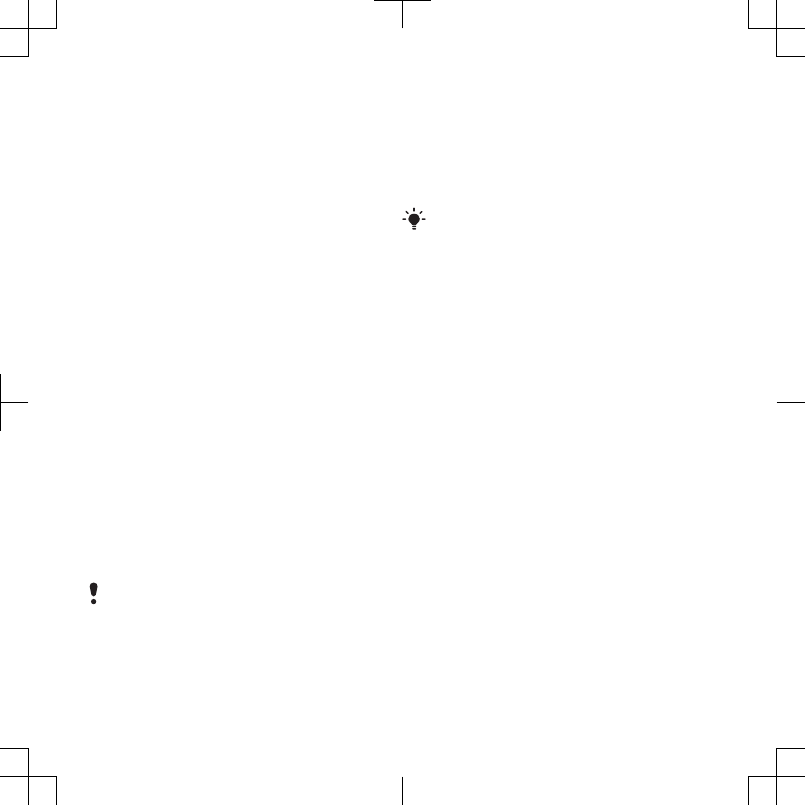
To move items between the phone
memory and the memory card
1From standby select Menu > Organiser
> File manager.
2Find an item and select Options >
Manage file > Move.
3Select Memory card or Phone.
4Scroll to a folder and select Open.
5Select Paste.
To view information about content
1From standby select Menu > Organiser
> File manager.
2Find an item and select Options >
Information.
Sending content to another
phone
You can send content, for example, in
messages or using Bluetooth™
wireless technology.
To send content
1Scroll to an item and select Options >
Send.
2Select a transfer method.
Make sure the receiving device supports
the transfer method you select.
Transferring content to and
from a computer
You can use Sony Ericsson Media
Manager to transfer content between
your phone and a computer.
Sony Ericsson Media Manager software is
included on the CD that comes with your
phone and available for download at
www.sonyericsson.com/support.
When you move or copy content from
a computer to your phone
unrecognised content is saved in the
Other folder in File manager.
Required operating systems
You need one of these operating
systems to use the software included
on the CD:
•Microsoft® Windows Vista™ (32 bit
and 64 bit versions of: Ultimate,
Enterprise, Business, Home
Premium, Home Basic)
•Microsoft® Windows XP (Pro or
Home), Service Pack 2 or higher
To install Sony Ericsson Media
Manager
1Turn on your computer and insert the
CD. The CD starts automatically and
the installation window opens.
2Select a language and click OK.
30 Transferring and handling content
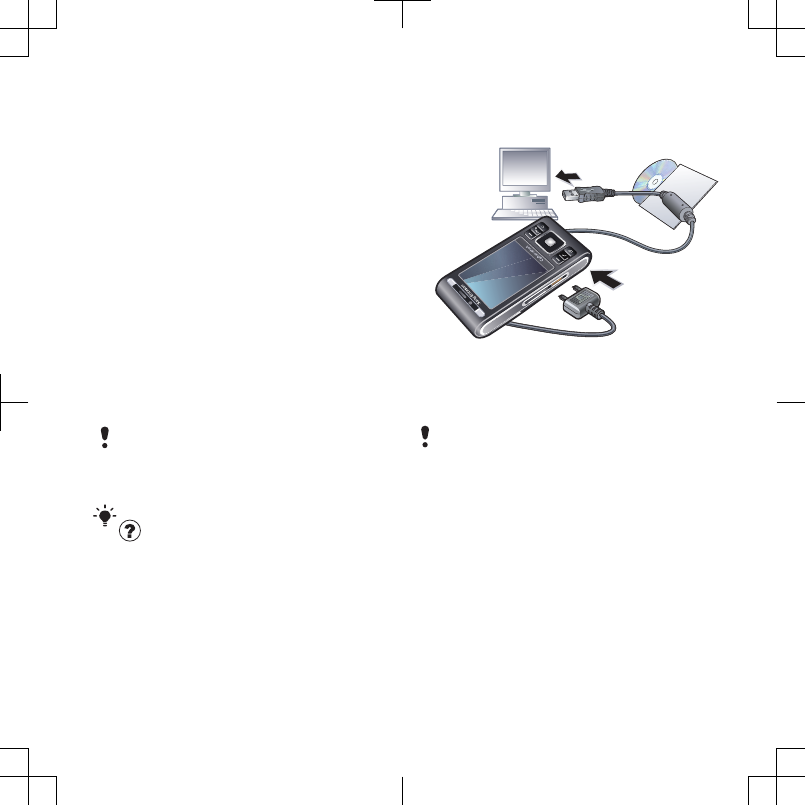
3Click Install Sony Ericsson Media
Manager and follow the instructions.
To transfer content using Sony
Ericsson Media Manager
1Connect the phone to a computer with
a USB cable supported by your phone.
2Computer: Start/Programs/
Sony Ericsson/Sony Ericsson Media
Manager.
3Phone: Select Media transfer.
4Computer: Select Portable device and
click OK.
5Wait until the phone appears in
Sony Ericsson Media Manager.
6Move files between your phone and the
computer in Sony Ericsson Media
Manager.
Do not remove the USB cable from your
phone or computer during transfer, as this
may corrupt the memory card or the
phone memory.
For details on transferring music, click
in the top right corner of the
Sony Ericsson Media Manager window.
Using the USB cable
You can connect your phone to a
computer with the USB cable to
synchronise, transfer and back up
phone content and use your phone as
a modem. For more information, go to
www.sonyericsson.com/support to
read Feature guides.
Before using the USB cable
See Required operating systems on
page 30.
Only use a USB cable supported by your
phone. Do not remove the USB cable
from your phone or computer during
transfer as this may corrupt the memory
card or the phone memory.
To disconnect the USB cable safely
1Computer: Close any software that you
are using with your phone.
2Disconnect the USB cable.
Drag and drop content
You can drag and drop content
between your phone, a memory card
Transferring and handling content 31

and a computer in Microsoft Windows
Explorer.
To drag and drop content
1Connect your phone to a computer
using the USB cable.
2Phone: Select Media transfer. The
phone will remain activated during file
transfer.
3Computer: Wait until the phone
memory and memory card appear as
external disks in Windows Explorer.
4Drag and drop selected files between
the phone and the computer.
Phone name
You can enter a name for your phone
that is shown to other devices when
using, for example, Bluetooth™
wireless technology.
To enter a phone name
1From standby select Menu > Settings >
the Connectivity tab > Phone name.
2Enter the phone name and select OK.
Using Bluetooth™ wireless
technology
The Bluetooth function makes wireless
connection to other Bluetooth devices
possible. You can, for example:
•Connect to handsfree devices.
•Connect to several devices at the
same time.
•Connect to computers and access
the Internet.
•Exchange items.
•Play multiplayer games.
A range within 10 metres (33 feet), with no
solid objects in between, is
recommended for Bluetooth
communication.
Before using Bluetooth wireless
technology
You must turn on the Bluetooth
function to communicate with other
devices. You may also have to pair your
phone with other Bluetooth devices.
To turn on the Bluetooth function
•From standby select Menu > Settings >
the Connectivity tab > Bluetooth > Turn
on.
Make sure that the device you want to pair
your phone with has the Bluetooth
function activated and Bluetooth visibility
turned on.
To pair the phone with a device
1From standby select Menu > Settings >
the Connectivity tab > Bluetooth > My
devices.
32 Transferring and handling content

2Scroll to New device and select Add to
search for available devices.
3Select a device.
4Enter a passcode, if required.
To allow connection to the phone
1From standby select Menu > Settings >
the Connectivity tab > Bluetooth > My
devices.
2Select a device from the list.
3Select Options > Allow connection.
4Select Always ask or Always allow.
This is only possible with devices that
require access to a secure service.
To pair the phone with a Bluetooth
handsfree for the first time
1From standby select Menu > Settings >
the Connectivity tab > Bluetooth >
Handsfree.
2Scroll to a device and select Yes.
3Enter a passcode, if required.
Power saving
You can save battery power with the
Power save function. In Power save
mode you can only connect with a
single Bluetooth device. If you want to
connect with more than one Bluetooth
device at the same time you must turn
this function off.
To turn on powersave
•From standby select Menu > Settings >
the Connectivity tab > Bluetooth >
Power save > On.
Transferring sound to and from a
Bluetooth handsfree
You can transfer the sound to and from
a Bluetooth handsfree using a phone
key or the handsfree key.
To transfer sound
1From standby select Menu > Settings >
the Connectivity tab > Bluetooth >
Handsfree > Incoming call.
2Select an option. In phone transfers
sound to the phone. In handsfree
transfers sound to the handsfree.
To transfer sound during a call
1During a call, select Sound.
2Select from the list.
Backing up and restoring
You can backup and restore contacts,
calendar, tasks, notes and bookmarks
using the Sony Ericsson PC Suite. You
can backup and restore content such
as music, pictures and video clips
using the Sony Ericsson Media
Manager.
Transferring and handling content 33
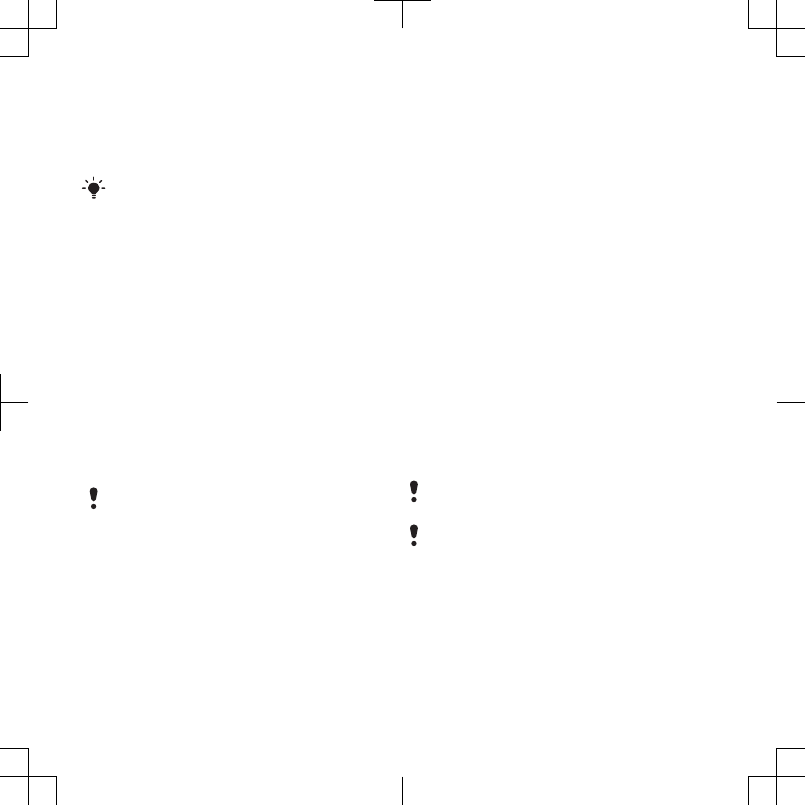
Before backing up and restoring, you
need to install the Sony Ericsson PC
Suite and the Sony Ericsson Media
Manager.
Always make a backup before having the
phone upgraded, since upgrading can
clear the user content.
To make a backup using the
Sony Ericsson PC Suite
1Computer: Start the Sony Ericsson PC
Suite from Start/Programs/
Sony Ericsson/Sony Ericsson PC
Suite.
2Follow the instructions in the
Sony Ericsson PC Suite for how to
connect.
3Phone: Select Phone mode.
4Computer: Go to the backup and
restore section in the Sony Ericsson PC
Suite and make a backup.
The Sony Ericsson PC Suite will overwrite
all the phone content during the restore
process. You may damage your phone if
you interrupt the process.
To restore phone content using the
Sony Ericsson PC Suite
1Computer: Start the Sony Ericsson PC
Suite from Start/Programs/
Sony Ericsson/Sony Ericsson PC
Suite.
2Follow the instructions in the
Sony Ericsson PC Suite for how to
connect.
3Phone: Select Phone mode.
4Computer: Go to the backup and
restore section in the Sony Ericsson PC
Suite and restore your phone.
To make a backup using the Sony
Ericsson Media Manager
1Connect your phone to the computer
using a USB cable.
2Phone: Select Media transfer mode.
3Computer: Start Sony Ericsson Media
Manager from Start/Programs/
Sony Ericsson/Sony Ericsson Media
Manager.
4Go to the backup section in the
Sony Ericsson Media Manager.
5Select the files you want to back up and
make a backup.
You can also connect your phone to a
computer using Bluetooth.
The Sony Ericsson Media Manager will
compare your phone content with your
computer backup and then restore files
missing in your phone. You may damage
your phone if you interrupt the process.
To restore phone content using the
Sony Ericsson Media Manager
1Connect your phone to the computer.
34 Transferring and handling content
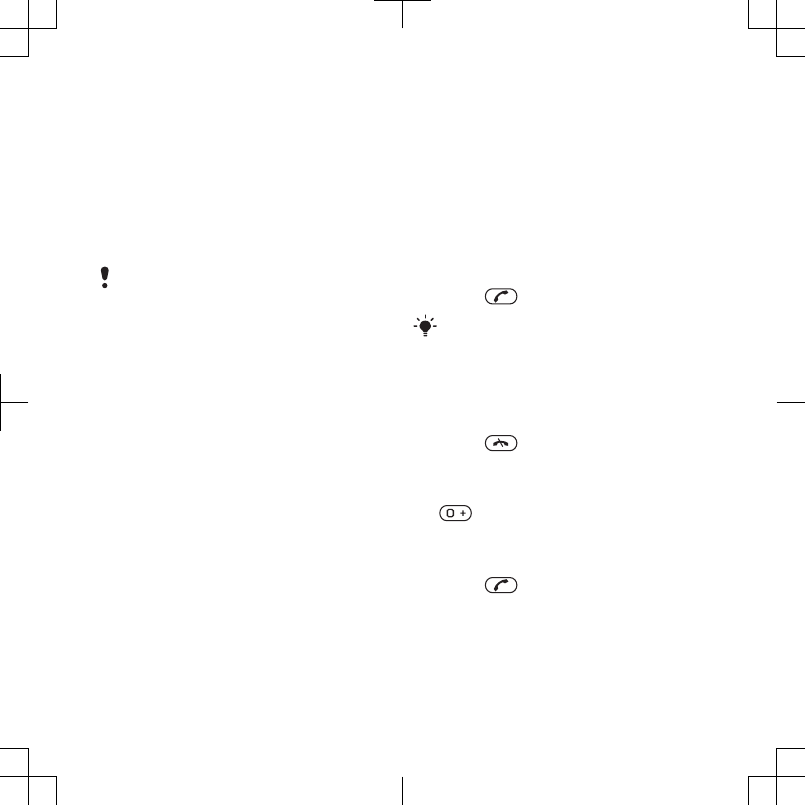
2Phone: Select Media transfer mode.
3Computer: Start Sony Ericsson Media
Manager from Start/Programs/
Sony Ericsson/Sony Ericsson Media
Manager.
4Go to the backup section in the
Sony Ericsson Media Manager.
5Select the files you want to restore and
restore them.
For more information on backing up and
restoring in Sony Ericsson Media
Manager see the Sony Ericsson Media
Manager Feature guide at
www.sonyericsson.com/support.
Calling
Making and receiving calls
You need to turn on your phone and be
within range of a network.
To make a call
1From standby enter a phone number
(with international country/region code
and area code, if applicable).
2Press .
You can call numbers from your contacts
and call list. See Contacts on page 37,
and Call list on page 36. You can also
use your voice to make calls. See Voice
control on page 41.
To end a call
•Press .
To make international calls
1From standby press and hold down
until a “+” sign appears.
2Enter the country/region code, area
code (without the first zero) and phone
number.
3Press .
Calling 35
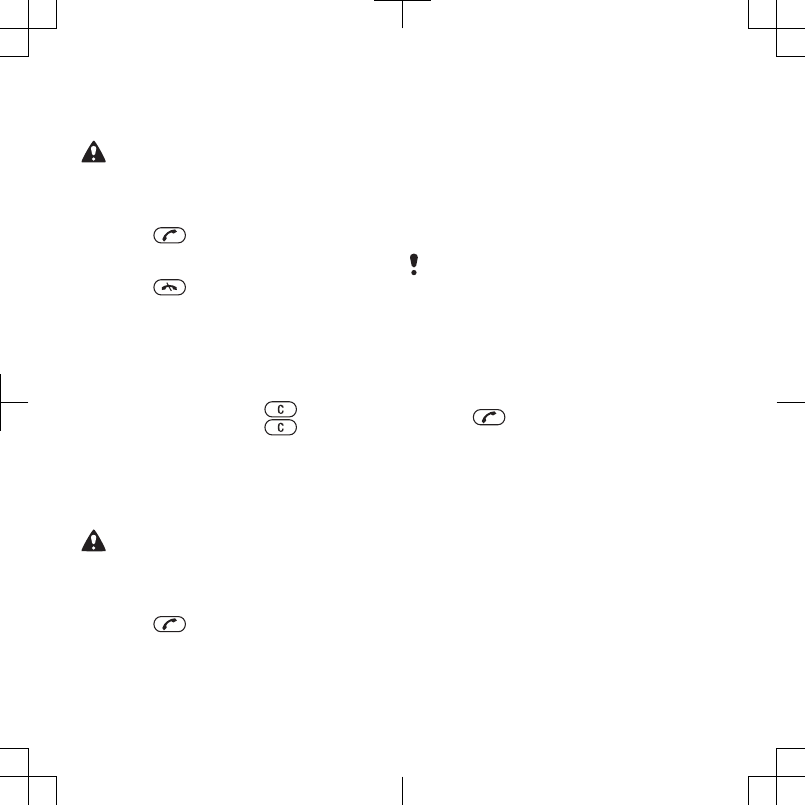
To re-dial a number
•When Retry? appears select Yes.
Do not hold your phone to your ear when
waiting. When the call connects, your
phone gives a loud signal.
To answer a call
•Press .
To reject a call
•Press .
To change the ear speaker volume
during a call
•Press the volume key up or down.
To mute the microphone during a call
1Press and hold down .
2Press and hold down again to
resume.
To turn on the loudspeaker during a
call
•Press SpkrOn.
Do not hold your phone to your ear when
using the loudspeaker. This could
damage your hearing.
To view missed calls from standby
•Press to open the call list.
Emergency calls
Your phone supports international
emergency numbers, for example, 112
and 911. You can normally use these
numbers to make emergency calls in
any country/region, with or without the
SIM card inserted, if you are within
range of a network.
In some countries/regions, other
emergency numbers may also be
promoted. Your network operator may
therefore have saved additional local
emergency numbers on the SIM card.
To make an emergency call
•From standby enter 112 (the
international emergency number) and
press .
To view your local emergency
numbers
1From standby select Menu > Contacts.
2Scroll to New contact and select
Options > Special numbers >
Emergency nos..
Call list
You can view information about recent
calls.
36 Calling
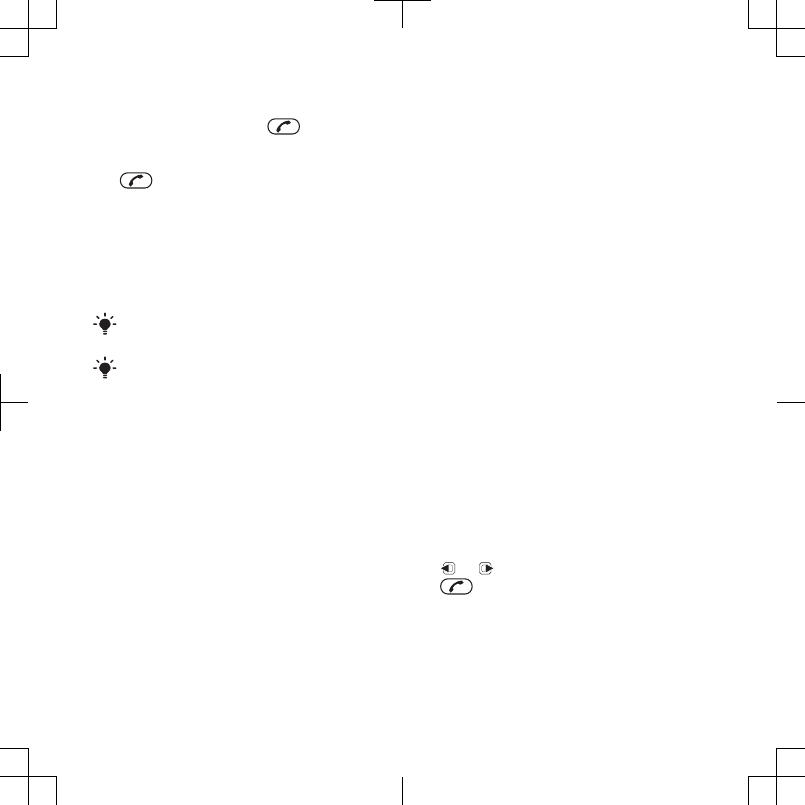
To call a number from the call list
1From standby press and scroll to
a tab.
2Scroll to a name or a number and press
.
Contacts
You can save names, phone numbers
and personal information in Contacts.
Information can be saved in the phone
memory or on the SIM card.
You can synchronise your contacts using
the Sony Ericsson PC Suite.
Please add the area code when you save
fixed line numbers in your phone.
Default contacts
You can choose which contact
information is shown as default. If
Phone contacts is selected as default,
your contacts show all the information
saved in Contacts. If you select SIM
contacts as default, your contacts
show names and numbers saved on
the SIM card.
To select default contacts
1From standby select Menu > Contacts.
2Scroll to New contact and select
Options > Advanced > Default contacts.
3Select an option.
Phone contacts
Phone contacts can contain names,
phone numbers and personal
information. They are saved in the
phone memory.
To add a phone contact
1From standby select Menu > Contacts.
2Scroll to New contact and select Add.
3Enter the name and select OK.
4Scroll to New number: and select Add.
5Enter the number and select OK.
6Select a number option.
7Scroll between the tabs and add
information to the fields.
8Select Save.
Calling contacts
To call a contact written in Chinese
characters
1From standby select Menu > Contacts.
Enter the entire multi-letter name, pure
initial or mixed initial Pinyin of Chinese
contacts you want to call.
2When the contact is highlighted, press
or to select a number. Press
.
To call a contact written in Latin
characters
1From standby select Menu > Contacts.
Scroll to, or enter, the first letters or all
Calling 37
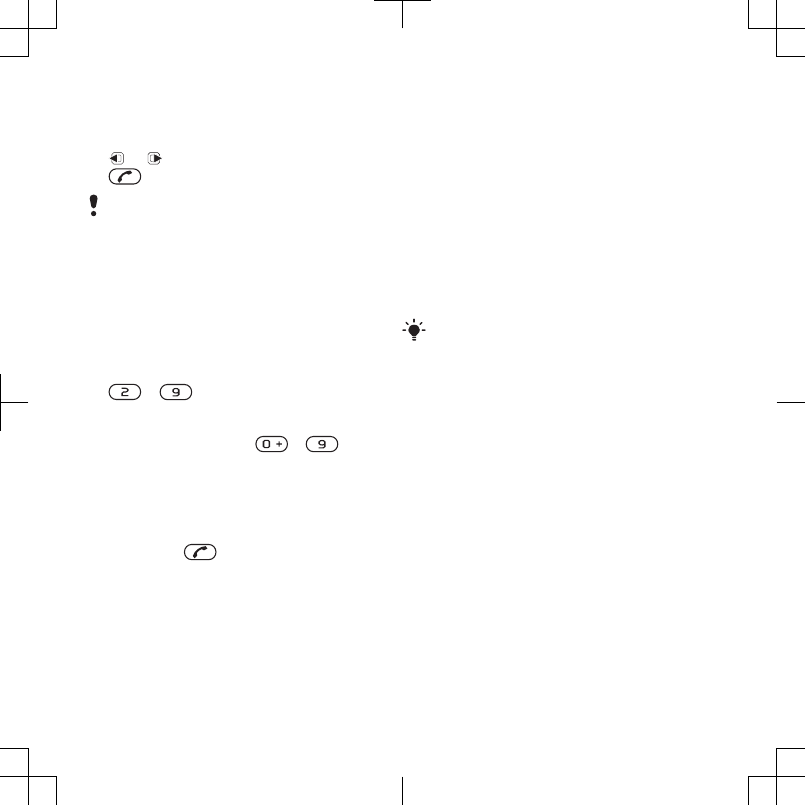
letters of the contact you want to call (a
maximum of 10 letters).
2When the contact is highlighted, press
or to select a number. Press
.
Your phone supports Chinese and
English contacts mixed search. When a
contact is written in Latin characters, the
entered letter can reach the Latin contact
you want to call; when a contact is written
in Chinese characters, the entered letter
can reach the Pinyin of the Chinese
contact you want to call.
To go directly to the contacts list
•From standby press and hold down
– .
To call with Smart search
1From standby press – to
enter a sequence of (at least two) digits.
All entries which match the sequence
of digits or corresponding letters are
shown in a list.
2Scroll to a contact or a phone number
and press .
To turn on or off Smart search
1From standby select Menu > Settings >
the Calls tab > Smart search.
2Select an option.
Editing contacts
To add information to a phone
contact
1From standby select Menu > Contacts.
2Scroll to a contact and select Options >
Edit contact.
3Scroll between the tabs and select
Add or Edit.
4Select an option and an item to add or
edit.
5Select Save.
If your subscription supports Calling Line
Identification (CLI) service, you can assign
personal ringtones and pictures to
contacts.
To copy names and numbers to
phone contacts
1From standby select Menu > Contacts.
2Scroll to New contact and select
Options > Advanced > Copy from SIM.
3Select an option.
To copy names and numbers to the
SIM card
1From standby select Menu > Contacts.
2Scroll to New contact and select
Options > Advanced > Copy to SIM.
38 Calling

3Select an option.
When you copy all contacts from your
phone to the SIM card, all existing SIM
card information is replaced.
To automatically save names and
phone numbers on the SIM card
1From standby select Menu > Contacts.
2Scroll to New contact and select
Options > Advanced > Auto save on
SIM.
3Select an option.
To save contacts on a memory card
1From standby select Menu > Contacts.
2Scroll to New contact and select
Options > Advanced > Back up to m.
card.
SIM contacts
SIM contacts can contain names and
numbers only. They are saved on the
SIM card.
To add a SIM contact
1From standby select Menu > Contacts.
2Scroll to New contact and select Add.
3Enter the name and select OK.
4Enter the number and select OK.
5Select a number option and add more
information, if available.
6Select Save.
Deleting contacts
To delete all contacts
1From standby select Menu > Contacts.
2Scroll to New contact and select
Options > Advanced > Delete all
contacts.
3Select an option.
Contact memory status
The number of contacts you can save
in your phone or on the SIM card
depends on available memory.
To view contact memory status
1From standby select Menu > Contacts.
2Scroll to New contact and select
Options > Advanced > Memory status.
Myself
You can enter information about
yourself and, for example, send your
business card.
To enter Myself information
1From standby select Menu > Contacts.
2Scroll to Myself and select Open.
3Scroll to an option and edit the
information.
4Select Save.
To add your own business card
1From standby select Menu > Contacts.
Calling 39
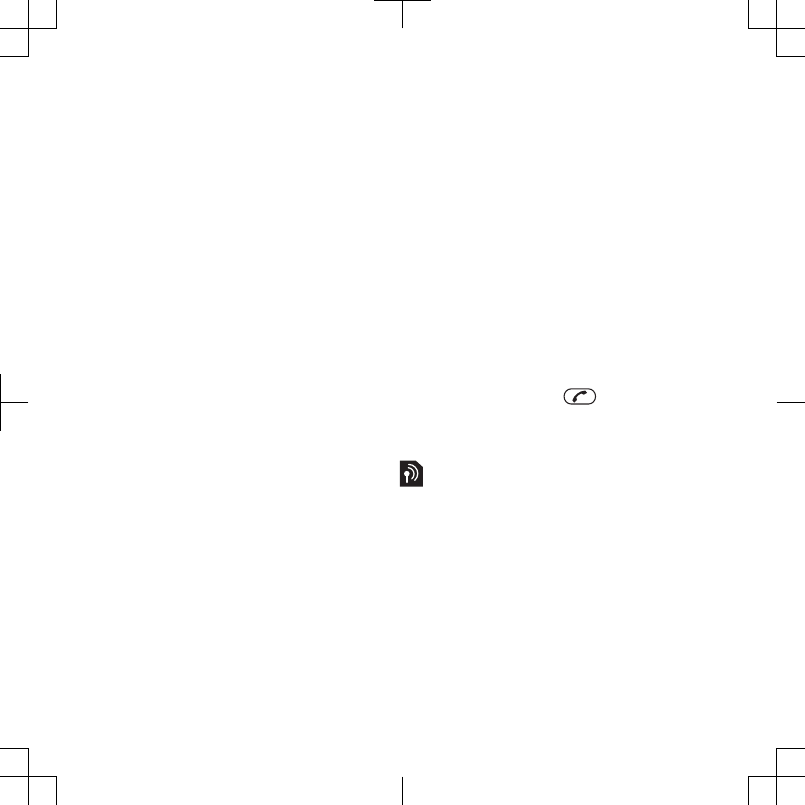
2Scroll to Myself and select Open.
3Scroll to My contact info and select
Add > Create new.
4Scroll between the tabs and add
information to the fields.
5Enter the information and select Save.
Groups
You can create a group of phone
numbers and email addresses from
Phone contacts to send messages to.
See Messaging on page 44. You can
also use groups (with phone numbers)
when you create accepted callers lists.
See Accept calls on page 43.
To create a group of numbers and
email addresses
1From standby select Menu > Contacts.
2Scroll to New contact and select
Options > Groups.
3Scroll to New group and select Add.
4Enter a name for the group and select
Continue.
5Scroll to New and select Add.
6For each contact phone number or
email address you want to mark, scroll
to it and select Mark.
7Select Continue > Done.
Speed dial
Speed dialling lets you select nine
contacts that you can dial quickly. The
contacts can be saved in positions 1-9.
To add contacts to speed dial
numbers
1From standby select Menu > Contacts.
2Scroll to New contact and select
Options > Speed dial.
3Scroll to a position number and select
Add.
4Select a contact.
To speed dial
•From standby enter the position
number and press .
More calling features
Voicemail
If your subscription includes an
answering service, callers can leave a
voicemail message when you cannot
answer a call.
To enter your voicemail number
1From standby select Menu >
Messaging > Messages > Settings > the
Message settings tab > Voicemail
number.
2Enter the number and select OK.
40 Calling
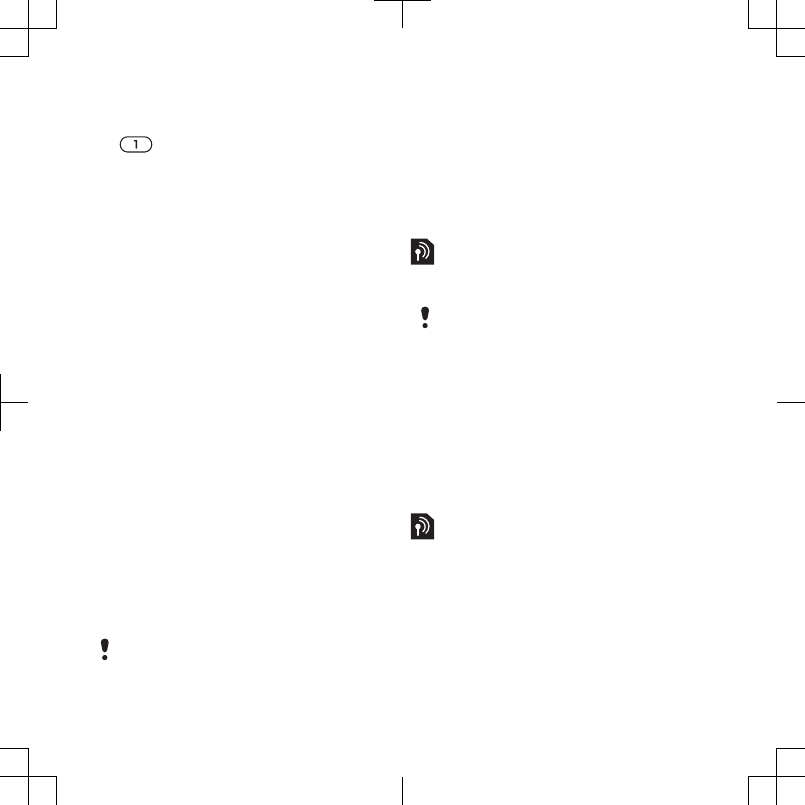
To call your voicemail service
•From standby press and hold down
.
Voice control
By creating voice commands you can:
•Voice dial – call someone by saying
their name
•Answer and reject calls when you
use a handsfree
To record a voice command using
voice dialling
1From standby select Menu > Settings >
the General tab > Voice control > Voice
dialling > Activate.
2Select Yes > New voice command and
select a contact. If the contact has
more than one number, select the
number to add the voice command to.
3Record a voice command such as
“John mobile.”
4Follow the instructions that appear.
Wait for the tone and say the command
to record. The voice command is
played back to you.
5If the recording sounds OK, select Yes.
If not, select No and repeat steps 3 and
4.
Voice commands are saved in the phone
memory only. They cannot be used in
another phone.
To voice dial
1From standby press and hold down a
volume key.
2Wait for the tone and say a recorded
name, for example “John mobile.” The
phone plays the name back to you and
connects the call.
Diverting calls
You can divert calls, for example, to an
answering service.
When Restrict calls is used, some divert
call options are not available. See
Restricted dialling on page 43.
To divert calls
1From standby select Menu > Settings >
the Calls tab > Divert calls.
2Select a call type and a divert option.
3Select Activate.
4Enter the number to divert calls to and
select OK.
More than one call
You can handle more than one call at a
time. For example, you can put an
ongoing call on hold, while you make or
answer a second call. You can also
switch between the two calls. You
cannot answer a third call without
ending one of the first two calls.
Calling 41
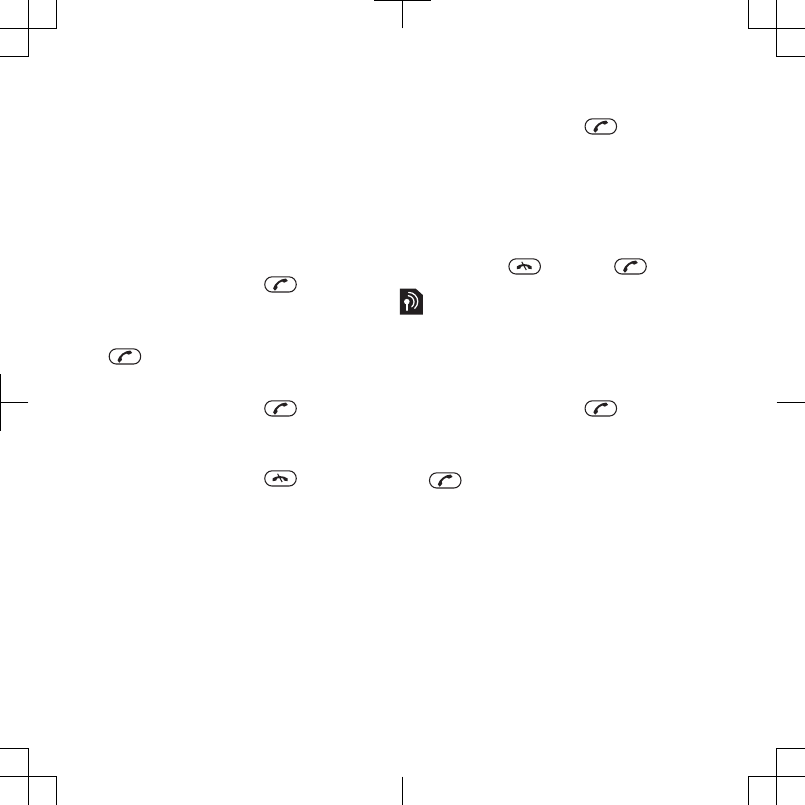
Call waiting
You will hear a beep if you receive a
second call while call waiting is active.
To activate call waiting
•From standby select Menu > Settings >
the Calls tab > Manage calls > Call
waiting > Activate.
To make a second call
1During the call, press . This puts
the ongoing call on hold.
2Select Options > Add call.
3Enter the number to call and press
.
To answer a second call
•During the call, press . This puts
the ongoing call on hold.
To reject a second call
•During the call, press and
continue with the ongoing call.
To end an ongoing call and answer a
second call
•During the call, select Replace active
call.
Handling two voice calls
You can have calls ongoing and on
hold at the same time.
To switch between two calls
•During the call, press .
To join two calls
•During the call, select Options > Join
calls.
To end an ongoing call and return to
the call on hold
•First press and then .
Conference calls
With a conference call, you can have a
joint conversation with up to five
people.
To add a new participant
1During the call, press . This puts
the joined calls on hold.
2Select Options > Add call.
3Enter the number to call and press
.
4Select Options > Join calls to add the
new participant.
5Repeat this task to add more
participants.
To release a participant
1Select Options > Release party.
2Select the participant to release.
42 Calling
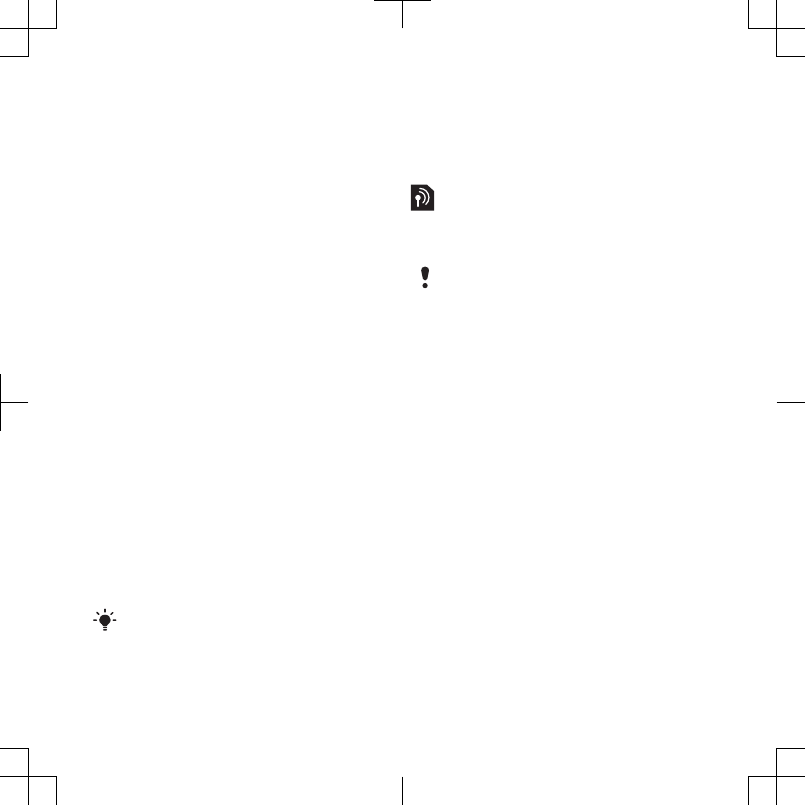
To have a private conversation
1During the call, select Options > Talk
to and select the participant to talk to.
2To resume the conference call, select
Options > Join calls.
My numbers
You can view, add and edit your own
phone numbers.
To check your phone numbers
1From standby select Menu > Contacts.
2Scroll to New contact and select
Options > Special numbers > My
numbers.
3Select an option.
Accept calls
You can choose to receive calls from
certain phone numbers only.
To add numbers to the accepted
callers list
1From standby select Menu > Settings >
the Calls tab > Manage calls > Accept
calls > Only from list.
2Scroll to New and select Add.
3Select a contact or Groups.
See Groups on page 40.
To accept all calls
•From standby select Menu > Settings >
the Calls tab > Manage calls > Accept
calls > All callers.
Restricted dialling
You can restrict outgoing and incoming
calls. A password from your service
provider is required.
If you divert incoming calls, you cannot
use some restrict calls options.
Restrict calls options
Standard options are:
•All outgoing – all outgoing calls
•Outgoing intl – all outgoing
international calls
•Outgoing intl roam. – all outgoing
international calls except to your
home country/region
•All incoming – all incoming calls
•Inc. when roaming – all incoming calls
when you are abroad
To restrict calls
1From standby select Menu > Settings >
the Calls tab > Manage calls > Restrict
calls.
2Select an option.
3Select Activate.
4Enter your password and select OK.
Calling 43
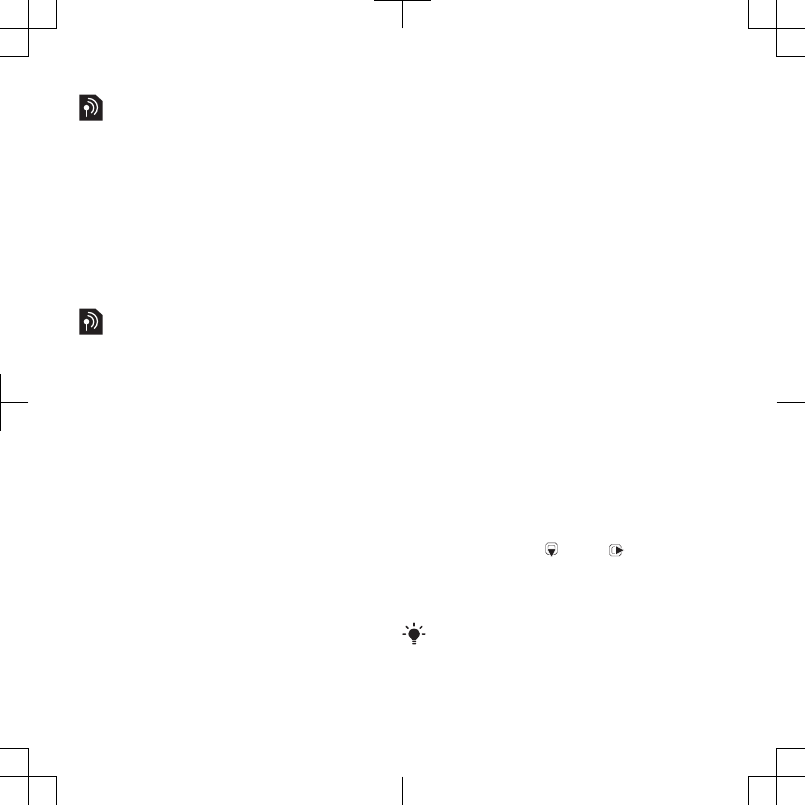
Call time and cost
During a call, the phone shows how
long you have been talking. You can
also check on the duration of your last
call, your outgoing calls and the total
time of all your calls.
To check the call time
•From standby select Menu > Settings >
the Calls tab > Time & cost > Call
timers.
Showing or hiding your phone number
You can decide to show or hide your
phone number when you make a call.
To hide your phone number
1From standby select Menu > Settings >
the Calls tab > Show/hide my no..
2Select Hide number.
Messaging
Text and picture messages
Messages can contain pictures, sound
effects, animations, and melodies. You
can also create and use templates for
your messages.
When sending messages, the phone
selects the best method (as a text or
picture message) for sending the
message.
If you cannot use picture messages,
see I cannot use Internet-based
services on page 68.
Sending messages
You can send messages from your
phone.
To create and send a message
1From standby select Menu >
Messaging > Write new > Message.
2Enter text. To add items to the
message, press , scroll and select
an item.
3Select Continue > Contacts look-up.
4Select a recipient and select Send.
If you send a message to a group, you will
be charged for each member. See
Groups on page 40.
44 Messaging
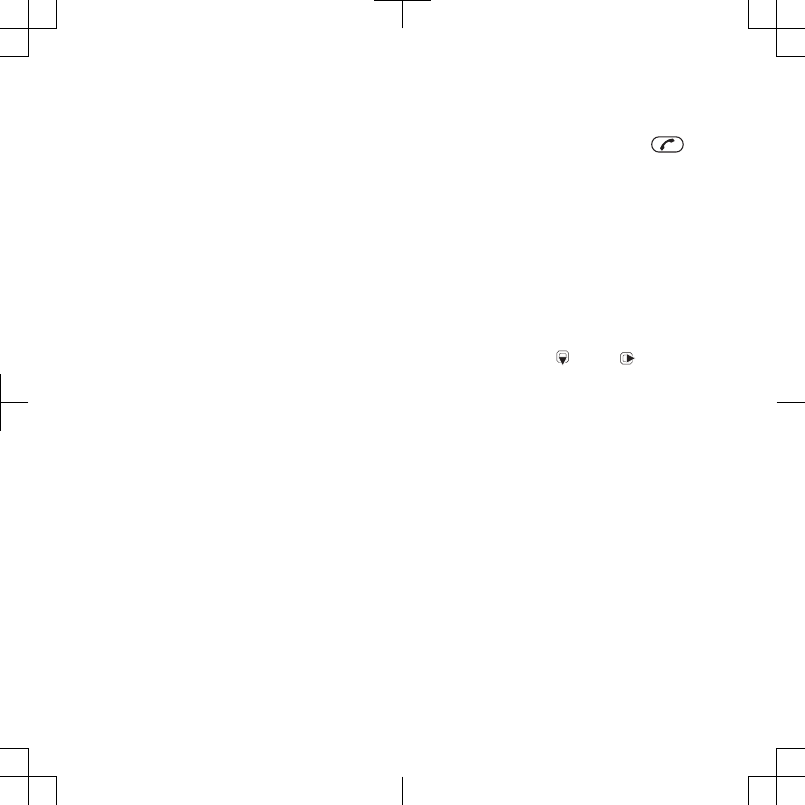
To copy and paste text in a message
1When you write the message, select
Options > Copy & paste.
2Select Copy all or Mark & copy. Scroll to
and mark text in the message.
3Select Options > Copy & paste > Paste.
Receiving and saving messages
You are notified when you receive a
message. Messages are automatically
saved in the phone memory. When the
phone memory is full, you can delete
messages or save them on a memory
card or on the SIM card.
To save a message on a memory card
•From standby select Menu >
Messaging > Messages > Settings >
Save to > Memory card.
To save a message on the SIM card
1From standby select Menu >
Messaging and select a folder.
2Scroll to a message and select
Options > Save message.
To view a message from the inbox
1From standby select Menu >
Messaging > Inbox.
2Scroll to the message and select View.
To call a number in a message
•When you view the message, scroll to
the phone number and press .
Templates
If you often use the same phrases and
pictures in a message, you can save
the message as a template.
To add a message template
1From standby select Menu >
Messaging > Messages > Templates >
New template > Add.
2Enter text. To add items to the
message, press , scroll and select
an item.
3Select Save, enter a title and select
Accept.
To save a message as a template
1From standby select Menu >
Messaging > Inbox.
2Scroll to the message and select View
> Options > Save as template.
Message options
You can set some options, such as the
Message alert and default storage
location, to apply to all messages. You
can set other options, such as the
Delivery priority and Delivery time, for
each message you send.
Messaging 45
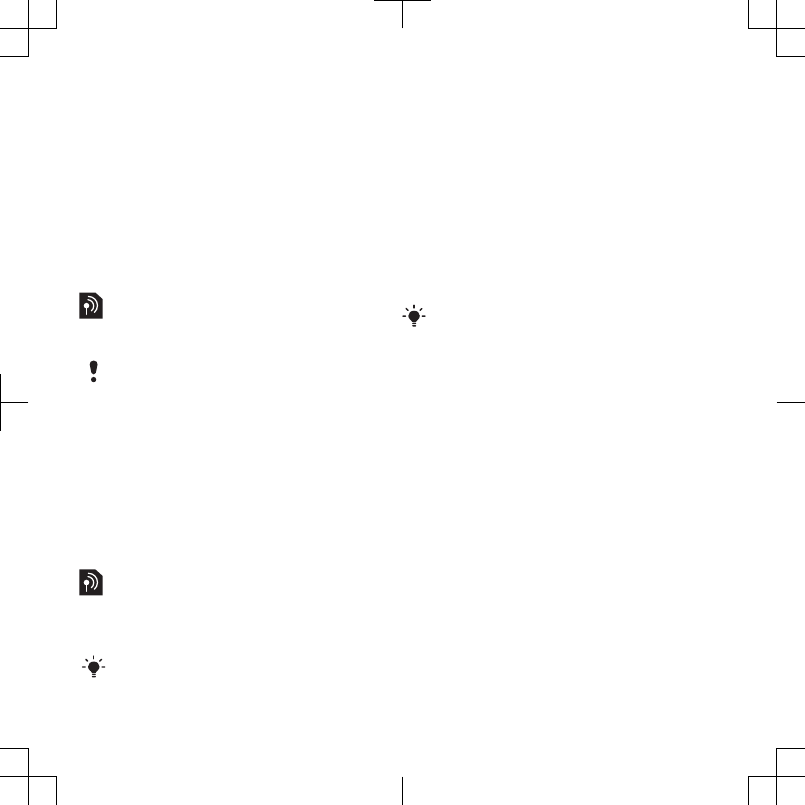
To set options for all messages
1From standby select Menu >
Messaging > Messages > Settings.
2Scroll to an option and choose Select.
To set options for a specific message
1When the message is ready and a
recipient is selected, select Options >
Advanced.
2Scroll to an option and select Edit.
Voice messages
You can send and receive a sound
recording as a voice message.
The sender and recipient must have a
subscription supporting picture
messaging.
To record and send a voice message
1From standby select Menu >
Messaging > Write new > Voice
message.
2Record the message and select Stop >
Send > Contacts look-up.
3Select a recipient and select Send.
Email
You can use standard email functions
and your computer email address in
your phone.
You can synchronise your email using
Microsoft® Exchange ActiveSync.
Before using email
You can use the setup wizard to check
if settings are available for your email
account or you can enter them
manually. You can also receive settings
at www.sonyericsson.com/support.
To create an email account
1From standby select Menu >
Messaging > Email > Accounts.
2Scroll to New account and select Add.
If you enter settings manually, you can
contact your email provider for more
information. An email provider could be
the company that supplied your email
address.
To write and send an email message
1From standby select Menu >
Messaging > Email > Write new.
2Select Add > Enter email address. Enter
the email address and select OK.
3To add more recipients, scroll to To:
and select Edit.
4Scroll to an option and select Add >
Enter email address. Enter the email
address and select OK. When you are
ready, select Done.
5Select Edit and enter a subject. Select
OK.
6Select Edit and enter the text. Select
OK.
46 Messaging

7Select Add and choose a file to attach.
8Select Continue > Send.
To receive and read an email
message
1From standby select Menu >
Messaging > Email > Inbox > Options >
Check new email.
2Scroll to the message and select View.
To save an email message
1From standby select Menu >
Messaging > Email > Inbox.
2Scroll to the message and select View
> Options > Save message.
To reply to an email message
1From standby select Menu >
Messaging > Email > Inbox.
2Scroll to the message and select
Options > Reply.
3Write the reply and select OK.
4Select Continue > Send.
To view an attachment in an email
message
•When you view the message, select
Options > Attachments > Use > View.
Active email account
If you have several email accounts, you
can change which one is active.
To change the active email account
1From standby select Menu >
Messaging > Email > Accounts.
2Select an account.
Push email
You can receive notification in your
phone from your email server that you
have new email messages.
To turn on push email notification
•From standby select Menu >
Messaging > Email > Settings > Push
email.
Instant messaging
You can connect and log in to the
Instant messaging server to
communicate online with chat
messages. If you cannot use Instant
messaging, see I cannot use Internet-
based services on page 68.
Before using Instant messaging
If no settings exist in your phone, you
need to enter server settings. Your
service provider can provide standard
settings information such as:
•Username
•Password
•Server address
•Internet profile
Messaging 47

To enter Instant messaging server
settings
1From standby select Menu >
Messaging > IM > Configure.
2Scroll to a setting and select Add.
To log in to the Instant messaging
server
•From standby select Menu >
Messaging > IM > Log in.
To log out of the Instant messaging
server
•Select Options > Log out.
To add a chat contact
1From standby select Menu >
Messaging > IM > the Contacts tab.
2Select Options > Add contact.
To send a chat message
1From standby select Menu >
Messaging > IM > the Contacts tab.
2Scroll to a contact and select Chat.
3Write the message and select Send.
Status
You can show your status, for example,
Happy or Busy, to your contacts only.
You can also show your status to all
users on the Instant messaging server.
To view my status
1From standby select Menu >
Messaging > IM.
2You are the first contact listed.
To update your status
1From standby select Menu >
Messaging > IM > the Contacts tab.
2Scroll to your name and select
Change.
3Edit the information and select Save.
Chat group
A chat group can be started by your
service provider, by an individual
Instant messaging user or by yourself.
You can save chat groups by saving a
chat invitation or by searching for a
specific chat group.
To create a chat group
1From standby select Menu >
Messaging > IM > the Chat groups tab.
2Select Options > Add chat group > New
chat group.
3Select who to invite from your contacts
list and select Continue.
4Enter a short invitation text and select
Continue > Send.
48 Messaging
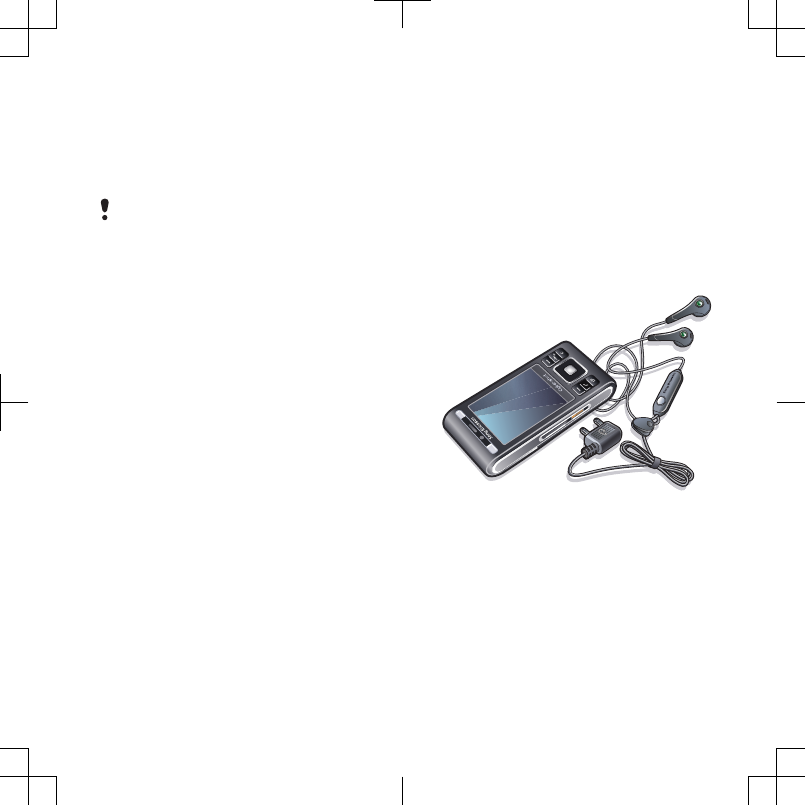
To add a chat group
1From standby select Menu >
Messaging > IM > the Chat groups tab
> Options > Add chat group.
2Select an option.
Conversation history is saved between
log out and when you log in again to let
you return to chat messages from
previous conversations.
To save a conversation
1From standby select Menu >
Messaging > IM > the Conversations
tab.
2Enter a conversation.
3Select Options > Advanced > Save
conversation.
Music
You can listen to music, audio books
and podcasts. Use Sony Ericsson
Media Manager to transfer content to
and from your phone. For more
information, see Transferring content
to and from a computer on page 30.
Stereo portable handsfree
To use the handsfree
•Connect the portable handsfree. Music
stops when you receive a call and
resumes when the call has ended.
Music 49

Music player
To play music
1From standby select Menu > Media >
Music.
2Browse by category using the
navigation key.
3Scroll to a title and select Play.
To stop playing music
•Press the centre selection key.
To fast forward and rewind
•Press and hold down or .
To move between tracks
•Press or .
To change the volume
•Press the volume key up or down.
To minimise the player
•Select Options > Minimise.
To return to the player
•From standby select Menu > Media.
Playlists
You can create playlists to organise
your music. You can add tracks to
more than one playlist.
Deleting a playlist, or a track from a
playlist, does not delete the track from
the memory, just the reference to the
track in that list.
It may take a few minutes for the phone to
create a playlist.
To create a playlist
1From standby select Menu > Media >
Music > Playlists.
2Scroll to New playlist and select Add.
3Enter a name and select OK.
4For each track you want to add, scroll
to the track and select Mark.
5Select Add to add the marked tracks to
the playlist.
To add tracks to a playlist
1From standby select Menu > Media >
Music > Playlists.
2Select a playlist.
3Scroll to Add music and select Add.
4For each track you want to add, scroll
to the track and select Mark.
5Select Add to add the marked tracks to
the playlist.
Audio books
You can listen to audio books you have
transferred to your phone from a
50 Music
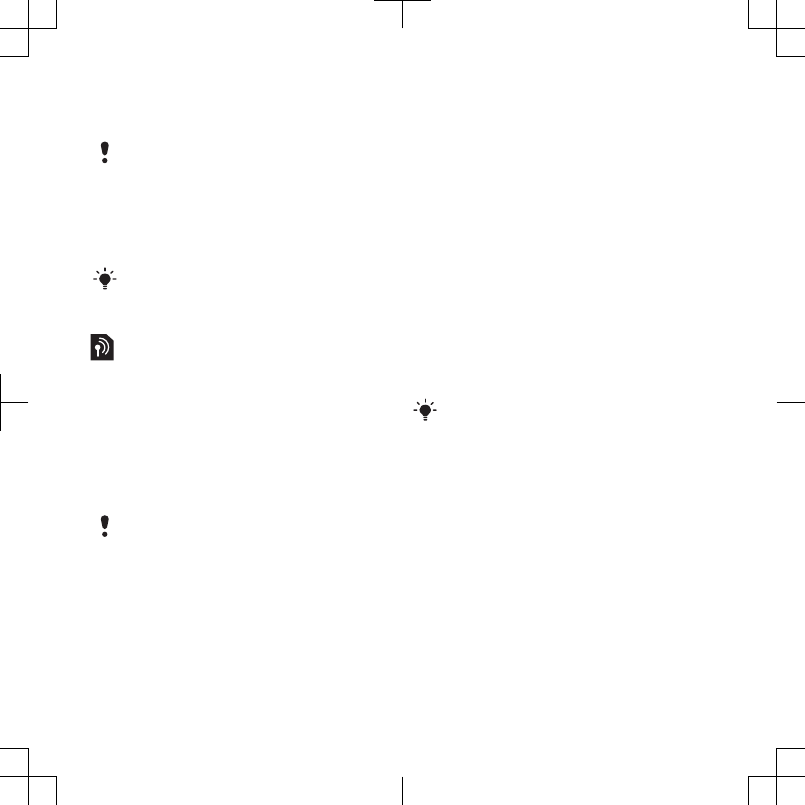
computer using Sony Ericsson Media
Manager.
It may take a few minutes before a
transferred audio book appears in the list
of available audio books.
To access audio books
•From standby select Menu > Media >
Music > Audio books.
You can find audio books in formats other
than M4B and those that do not have
ID3v2 chapter tags in the Tracks folder.
PlayNow™
You can connect to PlayNow™ to
download ringtones, games, music,
themes and wallpapers. You can
preview or listen to content before you
purchase and download it to your
phone. If you cannot use PlayNow™,
see I cannot use Internet-based
services on page 68.
This service is not available in all
countries/regions.
To use PlayNow™
1From standby select Menu >
PlayNow™.
2Scroll the PlayNow™ Web site and
follow the instructions to preview and
purchase content.
TrackID™
TrackID™ is a music recognition
service. You can search for title, artist
and album name for a track you hear
playing through a loudspeaker or on
the radio. If you cannot use TrackID™,
see I cannot use Internet-based
services on page 68.
To search for track information
•When you hear a track through a
loudspeaker, from standby select
Menu > Entertainment > TrackID™ >
Start.
•When the radio is playing select
Options > TrackID™.
For best results, use TrackID™ in a quiet
area.
Online music and video clips
You can view video clips and listen to
music by streaming them to your phone
from the Internet. If you cannot use the
Internet, see I cannot use Internet-
based services on page 68.
To select a data account for
streaming
1From standby select Menu > Settings >
the Connectivity tab > Streaming
settings > Connect using:.
2Select the data account to use.
Music 51

3Select Save.
To stream music and video clips
1From standby select Menu >
Monternet.
2Select Options > Go to > Bookmarks.
3Select a link to stream from.
Video player
To play videos
1From standby select Menu > Media >
Video > Videos.
2Scroll to a title and select Play.
To stop playing videos
•Press the centre selection key.
Radio
Do not use your phone as a radio in places
where this is prohibited.
To listen to the radio
1Connect the handsfree to the phone.
2From standby select Menu > Radio.
To search for channels automatically
•Select Search.
To search for channels manually
•Press or .
To change the volume
•Press the volume key up or down.
To minimise the radio
•Select Options > Minimise.
To return to the radio
•From standby select Menu > Radio.
Saving channels
You can save up to 20 preset channels.
To save channels
1When you have found a radio channel,
select Options > Save.
2Scroll to a position and select Insert.
To select saved channels
1Select Options > Channels.
2Select a radio channel.
To switch between saved channels
•Press or .
MusicDJ™
You can compose and edit your own
melodies to use as ringtones. Pre-
arranged sounds with different
characteristics are available.
To compose a melody
1From standby select Menu >
Entertainment > MusicDJ™.
52 Music

2Select to Insert, Copy or Paste sounds.
3Use , , or to scroll between the
sounds.
4Select Options > Save melody.
Record sound
You can record a voice memo or a call.
Recorded sounds can also be set as
ringtones.
In some countries/regions or states it is
required by law that you inform the other
person before recording the call.
To record a sound
•From standby select Menu >
Entertainment > Record sound >
Record.
To record a call
1During an ongoing call, select Options
> Record.
2Select Save to save the recording.
To listen to a recording
1From standby select Menu > Organiser
> File manager.
2Scroll to Music and select Open.
3Scroll to a recording and select Play.
Internet
If you cannot use the Internet, see I
cannot use Internet-based services on
page 68.
To start browsing
1From standby select Menu >
Monternet.
2Select Options > Go to.
3Select an option.
To exit the browser
•When you browse the Internet, select
Options > Exit browser.
Bookmarks
You can create and edit bookmarks as
quick links to your favourite Web
pages.
To create a bookmark
1When you browse the Internet, select
Options > Tools > Add bookmark.
2Enter a title and an address. Select
Save.
To select a bookmark
1From standby select Menu >
Monternet.
2Select Options > Go to > Bookmarks.
3Scroll to a bookmark and select Go to.
Internet 53
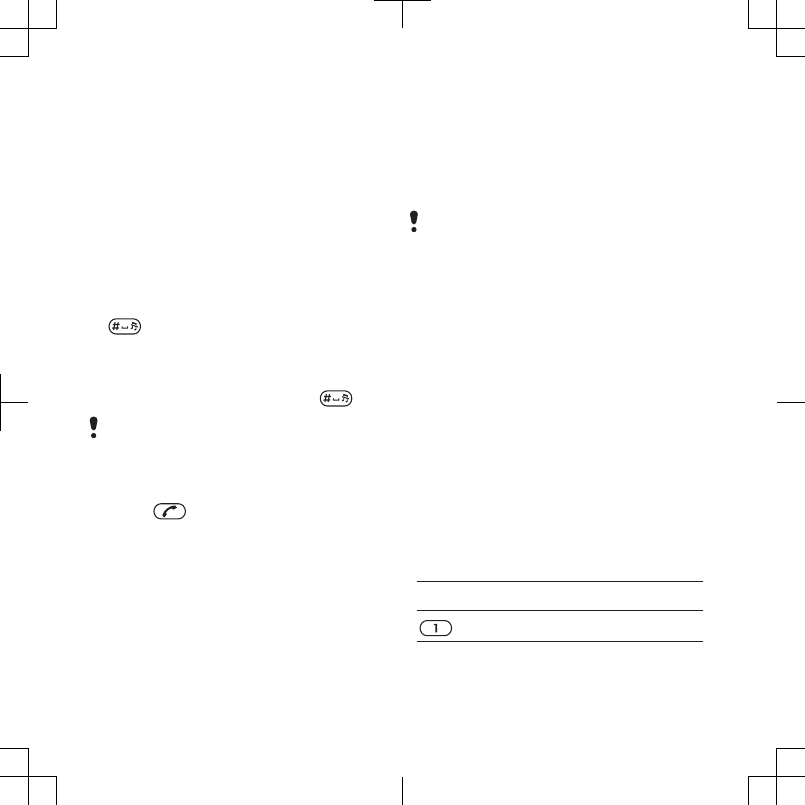
History pages
You can view Web pages you have
browsed.
To view history pages
•From standby select Menu >
Monternet > Options > Go to > History.
More browser features
To use pan and zoom on a Web page
1When you browse the Internet, press
.
2Use the navigation key to move the
frame.
3Press Zoom.
4To switch back to pan, press .
To use pan and zoom, you need to turn
off Smart-Fit: Options > Advanced >
Smart-Fit > Off.
To make a call when you browse
•Press .
To save a picture from a Web page
1When you browse the Internet, select
Options > Tools > Save picture.
2Select a picture.
To find text on a Web page
1When you browse the Internet, select
Options > Tools > Find on page.
2Enter text and press Find.
To send a link
1When you browse the Internet, select
Options > Tools > Send link.
2Select a transfer method.
Make sure the receiving device supports
the transfer method you select.
To change screen orientation in the
browser
1From standby select Menu >
Monternet.
2Select Options > Advanced >
Orientation.
3Select an option.
Internet keypad shortcuts
You can use the keypad to go directly
to an Internet browser function.
To select Internet keypad shortcuts
1From standby select Menu >
Monternet.
2Select Options > Advanced > Keypad
mode > Shortcuts.
Key Shortcut
Bookmarks
54 Internet
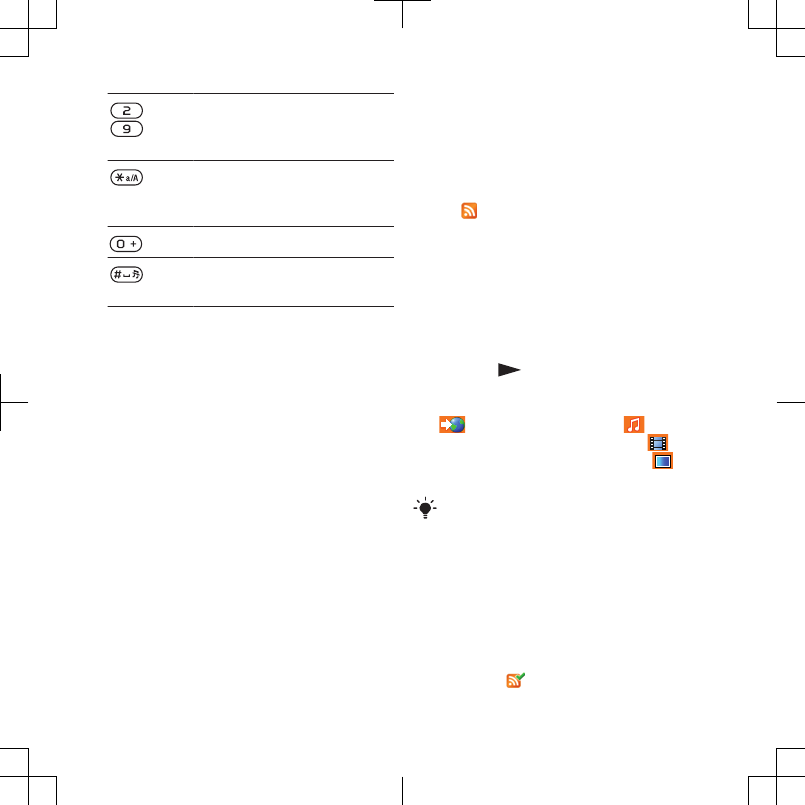
- Enter text to Enter address,
Search Internet or search in
Bookmarks
Fullscreen or Landscape or
Normal screen (when Auto
rotate is off)
Zoom
Pan & zoom (when Smart-
Fit is off)
Internet security and
certificates
Your phone supports secure browsing.
Certain Internet services, such as
banking, require certificates in your
phone. Your phone may already
contain certificates when you buy it or
you can download new certificates.
To view certificates in the phone
•From standby select Menu > Settings >
the General tab > Security >
Certificates.
Web feeds
You can subscribe to and download
frequently updated content, such as
news, podcasts or photos, using Web
feeds.
To add new feeds for a Web page
1When you browse a page on the
Internet that has Web feeds, indicated
by , select Options > Web feeds.
2For each feed you want to add, scroll
to the feed and select Mark.
3Select Options > Continue.
To download content via feeds
1From standby select Menu > Media >
Web feeds.
2Scroll to an updated feed and select
View or .
3Select a heading to expand.
4Select an icon depending on content,
to open a Web page, to
download an audio podcast, to
download a video podcast or to
download a photo.
You can also subscribe to and download
content to a computer via feeds using
Sony Ericsson Media Manager. You can
then transfer the content to your phone.
See Transferring content to and from a
computer on page 30.
Updating Web feeds
You can manually update your feeds,
or schedule updates. When there are
updates, appears on the screen.
Internet 55

To schedule Web feed updates
1From standby select Menu > Media >
Web feeds.
2Scroll to a feed and select Options >
Schedule update.
3Select an option.
Frequent updates may be costly.
Web feeds in standby
You can show news updates on the
standby screen.
To show Web feeds in standby
1From standby select Menu > Media >
Web feeds.
2Scroll to a feed and select Options >
Settings > Standby ticker > Show in
standby.
To access Web feeds from standby
1From standby select Ticker.
2To read more about a feed, press or
to scroll to a headline and select Go
to.
Podcasts
Podcasts are files, for example, radio
programmes or video content, that you
can download and play. You subscribe
to and download podcasts using Web
feeds.
To access audio podcasts
•From standby select Menu > Media >
Music > Podcasts.
To access video podcasts
•From standby select Menu > Media >
Video > Podcasts.
56 Internet
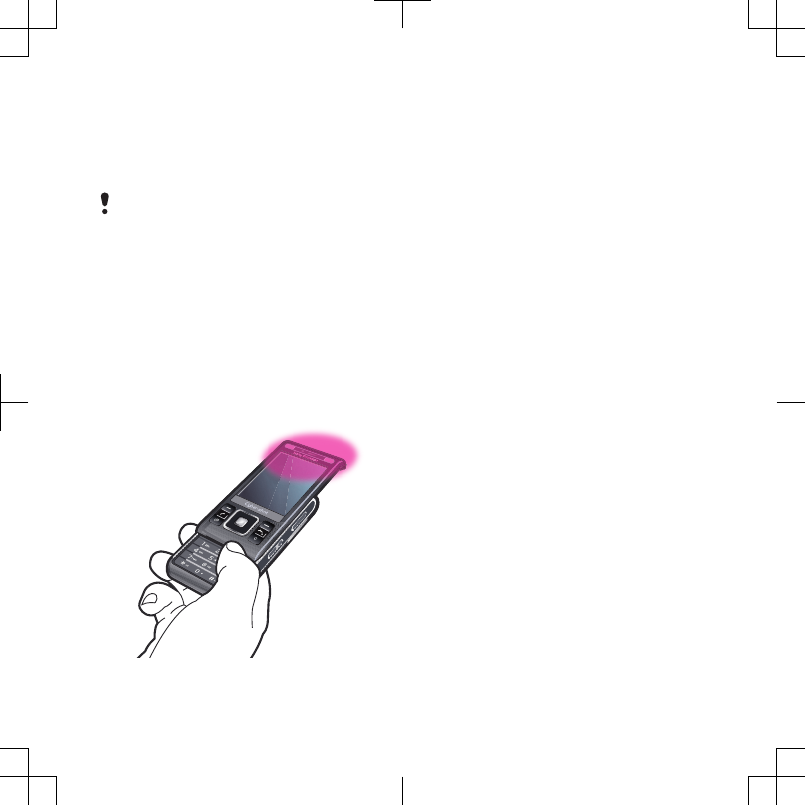
GPS
Your phone has a GPS receiver that
uses satellite signals to calculate your
location.
If you cannot use some GPS features, see
I cannot use Internet-based services on
page 68.
Using GPS
Your location can be found when you
have a clear view of the sky. If your
location is not found after a few
minutes, move to another location. To
help the search, stand still and do not
cover the GPS antenna.
More GPS features
Save locations
You can find all saved locations in My
favourites.
To save your current location
1From standby select Menu > Location
services > My favourites > Add new
place.
2Select Edit and enter the title. Select
OK.
3Scroll to Description: and select Add.
Enter the description and select OK.
4Scroll to Position: and select Add >
Current position.
5Select Save.
To view a saved location on a map
1From standby select Menu > Location
services > My favourites.
2Scroll to a location and select Go to.
Location requests
External services may ask for your
location.
To change access for external
services
1From standby select Menu > Location
services > Settings > Privacy.
2Select an option.
GPS 57

Turn off GPS
The GPS receiver turns off
automatically when it is not in use. You
can also turn the GPS receiver off
manually. This saves battery power
when you use features that do not
require the GPS receiver to find your
location.
To turn on or off GPS manually
1From standby select Menu > Location
services > Settings.
2Select Enable GPS or Disable GPS.
Synchronising
You can synchronise in two different
ways. You can synchronise your phone
using a computer program or you can
synchronise using an Internet service.
Use only one of the synchronisation
methods at a time with your phone.
For more information, go to
www.sonyericsson.com/support to
read the Synchronisation Feature
guide.
Synchronising using a
computer
You can use the USB cable or
Bluetooth wireless technology to
synchronise phone contacts,
appointments, bookmarks, tasks and
notes with a computer program such
as Microsoft Outlook.
Before synchronising, you need to
install the Sony Ericsson PC Suite.
Sony Ericsson PC Suite software is
included on the CD with your phone and
available for download at
www.sonyericsson.com/support
.
See Required operating systems on
page 30.
58 Synchronising

To install the Sony Ericsson PC Suite
1Turn on your computer and insert the
CD. The CD starts automatically and
the installation window opens.
2Select a language and click OK.
3Click Install Sony Ericsson PC suite and
follow the instructions on the screen.
To synchronise using the
Sony Ericsson PC Suite
1Computer: Start Sony Ericsson PC
Suite from Start/Programs/
Sony Ericsson/Sony Ericsson PC
Suite.
2Follow the instructions in the
Sony Ericsson PC Suite for how to
connect.
3Phone: Select Phone mode.
4Computer: When you are notified that
the Sony Ericsson PC Suite has found
your phone, you can start
synchronising.
For usage details, see the Sony Ericsson
PC Suite Help section once the software
has been installed on your computer.
Synchronising using an
Internet service
You can synchronise with an Internet
service using SyncML™ or a
Microsoft® Exchange Server using
Microsoft Exchange ActiveSync. For
more information, go to
www.sonyericsson.com/support to
read the Synchronisation Feature
guide.
Synchronising 59
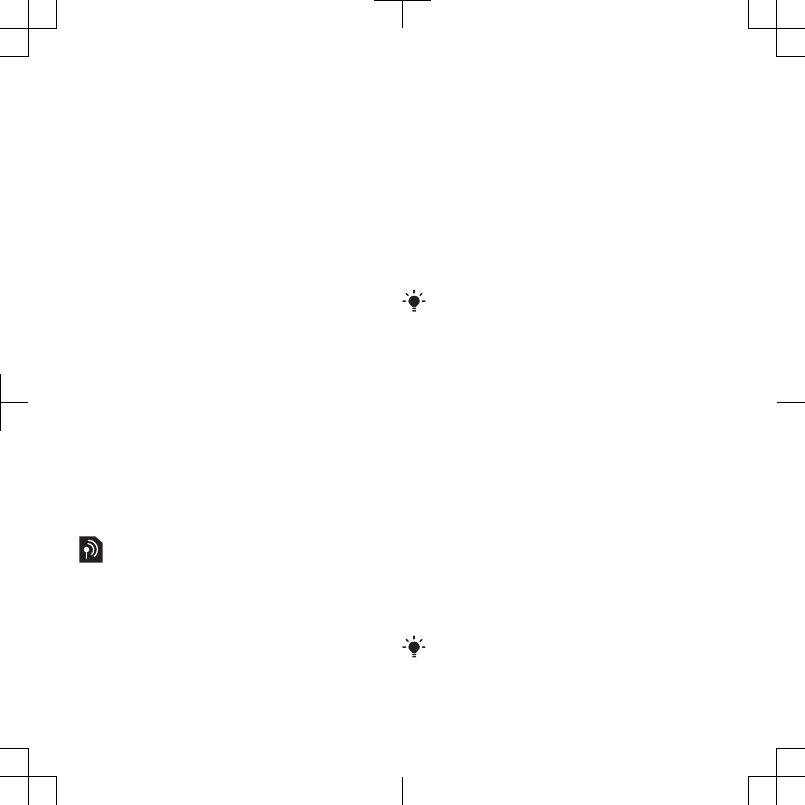
More features
Flight mode
In Flight mode the network and radio
transceivers are turned off to prevent
disturbance to sensitive equipment.
When the flight mode menu is activated
you are asked to select a mode the next
time you turn on your phone:
•Normal mode – full functionality
•Flight mode – limited functionality
To activate the flight mode menu
•From standby select Menu > Settings >
the General tab > Flight mode >
Continue > Show at startup.
To select flight mode
1When the flight mode menu is
activated, turn off your phone.
2Turn on your phone and select Flight
mode.
Update service
You can update your phone with the
latest software using your phone or a
PC.
To view the current software in the
phone
1From standby select Menu > Settings >
the General tab > Update service.
2Select Software version.
Update Service using the phone
You can update your phone over the air
using your phone. You do not lose
personal or phone information.
Update Service using your phone
requires data access such as GPRS.
To select update settings
•From standby select Menu > Settings >
the General tab > Update service >
Settings > Internet settings.
To use Update service using the
phone
1From standby select Menu > Settings >
the General tab > Update service.
2Select Search for update and follow the
instructions that appear.
Update service using a PC
You can update your phone using the
provided USB cable and an Internet
connected PC.
Make sure all personal data on your
phone's memory is backed up. All user
60 More features

data and settings will be overwritten
during the update using a PC. Data stored
on a memory stick will not be affected.
To use Update service using a PC
•Go to
www.sonyericsson.com/support.
Alarms
You can set a sound or the radio as an
alarm signal. The alarm sounds even if
the phone is turned off. When the alarm
sounds you can silence it or turn it off.
To set the alarm
1From standby select Menu > Organiser
> Alarms.
2Scroll to an alarm and select Edit.
3Scroll to Time: and select Edit.
4Enter a time and select OK > Save.
To set the recurrent alarm
1From standby select Menu > Organiser
> Alarms.
2Scroll to an alarm and select Edit.
3Scroll to Recurrent: and select Edit.
4Scroll to a day and select Mark.
5To select another day, scroll to the day
and select Mark.
6Select Done > Save.
To set the alarm signal
1From standby select Menu > Organiser
> Alarms.
2Scroll to an alarm and select Edit.
3Scroll to the tab.
4Scroll to Alarm signal: and select Edit.
5Find and select an alarm signal. Select
Save.
To silence the alarm
•When the alarm sounds, press any key.
•To repeat the alarm, select Snooze.
To turn off the alarm
•When the alarm sounds, select Turn
off.
To cancel the alarm
1From standby select Menu > Organiser
> Alarms.
2Scroll to an alarm and select Turn off.
The alarm in silent mode
You can set the alarm not to sound
when the phone is in silent mode.
To set an alarm to sound or not in
silent mode
1From standby select Menu > Organiser
> Alarms.
2Scroll to an alarm and select Edit.
3Scroll to the tab.
4Scroll to Silent mode: and select Edit.
More features 61

5Select an option.
To set the snooze duration
1From standby select Menu > Organiser
> Alarms.
2Scroll to an alarm and select Edit.
3Scroll to Snooze duration: and select
Edit.
4Select an option.
Calendar
You can synchronise your calendar with a
computer calendar, with a calendar on the
Web or with a Microsoft® Exchange
Server (Microsoft® Outlook®).
Appointments
You can add new appointments or
reuse existing appointments.
To add an appointment
1From standby select Menu > Organiser
> Calendar.
2Select a date.
3Scroll to New appointment and select
Add.
4Enter the information and confirm each
entry.
5Select Save.
To view an appointment
1From standby select Menu > Organiser
> Calendar.
2Select a date.
3Scroll to an appointment and select
View.
To edit an appointment
1From standby select Menu > Organiser
> Calendar.
2Select a date.
3Scroll to an appointment and select
View.
4Select Options > Edit.
5Edit the appointment and confirm each
entry.
6Select Save.
To set when reminders should sound
1From standby select Menu > Organiser
> Calendar.
2Select a date.
3Select Options > Advanced >
Reminders.
4Select an option.
A reminders option set in calendar affects
a reminders option set in tasks.
Notes
You can make notes and save them.
You can also show a note in standby.
62 More features

To add a note
1From standby select Menu > Organiser
> Notes.
2Scroll to New note and select Add.
3Write a note and select Save.
To show a note in standby
1From standby select Menu > Organiser
> Notes.
2Scroll to a note and select Options >
Show in standby.
To hide a note from standby
1From standby select Menu > Organiser
> Notes.
2Scroll to the note shown in standby.
This is marked with an icon. Select
Options > Hide in standby.
Tasks
You can add new tasks or reuse
existing tasks.
To add a task
1From standby select Menu > Organiser
> Tasks.
2Select New task and select Add.
3Select an option.
4Enter details and confirm each entry.
To set when reminders should sound
1From standby select Menu > Organiser
> Tasks.
2Scroll to a task and select Options >
Reminders.
3Select an option.
A reminders option set in tasks affects a
reminders option set in calendar.
Profiles
You can change settings such as the
ring volume and vibrating alert to suit
different locations. You can reset all
profiles to the phone’s original settings.
To select a profile
1From standby select Menu > Settings >
the General tab > Profiles.
2Select a profile.
To view and edit a profile
1From standby select Menu > Settings >
the General tab > Profiles.
2Scroll to a profile and select Options >
View and edit.
You cannot rename the Normal profile.
More features 63
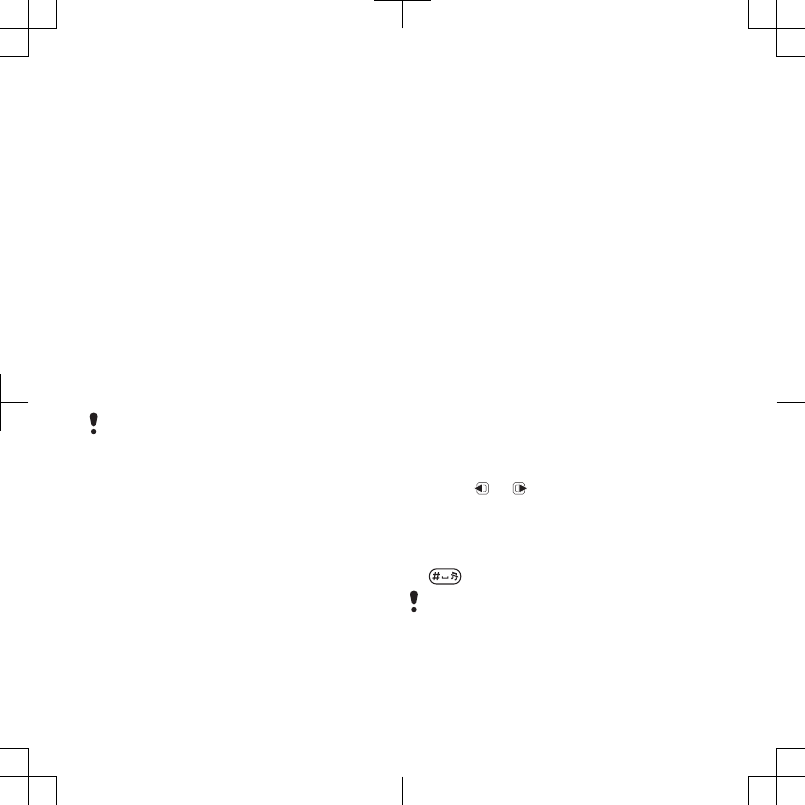
Time and date
To set the time
1From standby select Menu > Settings >
the General tab > Time & date > Time.
2Enter the time and select Save.
To set the date
1From standby select Menu > Settings >
the General tab > Time & date > Date.
2Enter the date and select Save.
To set the time zone
1From standby select Menu > Settings >
the General tab > Time & date > My time
zone.
2Select the time zone you are in.
If you select a city, My time zone also
updates the time when daylight saving
time changes.
Theme
You can change the appearance of the
screen through items such as colours
and wallpaper. You can also create
new themes and download them. For
more information, go to
www.sonyericsson.com/fun.
To set a theme
1From standby select Menu > Settings >
the Display tab > Theme.
2Scroll to a theme and select Set.
Main menu layout
You can change the layout of the icons
in the main menu.
To change the main menu layout
1From standby select Menu > Options >
Main menu layout.
2Select an option.
Ringtones
To set a ringtone
1From standby select Menu > Settings >
the Sounds & alerts tab > Ringtone.
2Find and select a ringtone.
To set the ringtone volume
1From standby select Menu > Settings >
the Sounds & alerts tab > Ring volume.
2Press or to change the volume.
3Select Save.
To turn off the ringtone
•From standby press and hold down
.
The alarm signal is not affected.
64 More features

To set the vibrating alert
1From standby select Menu > Settings >
the Sounds & alerts tab > Vibrating
alert.
2Select an option.
Screen orientation
You can change between landscape
and portrait orientation, or select Auto
rotate to have the orientation change
when you rotate the phone.
To change screen orientation in
Media
1From standby select Menu > Media >
Settings > Orientation.
2Select an option.
Games
Your phone contains preloaded
games. You can also download games.
Help texts are available for most
games.
To start a game
1From standby select Menu > Media >
Games.
2Select a game.
To end a game
•Press .
Applications
You can download and run Java
applications. You can also view
information or set different
permissions. If you cannot use Java
applications, see I cannot use Internet-
based services on page 68.
To select a Java application
1From standby select Menu > Organiser
> Applications.
2Select an application.
To set permissions for a Java
application
1From standby select Menu > Organiser
> Applications.
2Scroll to an application and select
Options > Permissions.
3Set permissions.
Java application screen size
Some Java applications are designed
for a specific screen size. For more
information, contact the application
vendor.
To set the screen size for a Java
application
1From standby select Menu > Organiser
> Applications.
More features 65

2Scroll to an application and select
Options > Screen size.
3Select an option.
Locks
SIM card lock
This lock only protects your
subscription. Your phone will work with
a new SIM card. If the lock is on, you
have to enter a PIN (Personal Identity
Number).
If you enter your PIN incorrectly three
times in a row, the SIM card is blocked
and you need to enter your PUK
(Personal Unblocking Key). Your PIN
and PUK are supplied by your network
operator.
To unblock the SIM card
1When PIN blocked appears, enter your
PUK and select OK.
2Enter a new four-to-eight-digit PIN and
select OK.
3Re-enter the new PIN and select OK.
To edit the PIN
1From standby select Menu > Settings >
the General tab > Security > Locks > SIM
protection > Change PIN.
2Enter your PIN and select OK.
3Enter a new four-to-eight-digit PIN and
select OK.
4Re-enter the new PIN and select OK.
If Codes do not match appears, you
entered the new PIN incorrectly. If Wrong
PIN appears, followed by Old PIN:, you
entered your old PIN incorrectly.
To use the SIM card lock
1From standby select Menu > Settings >
the General tab > Security > Locks > SIM
protection > Protection.
2Select an option.
3Enter your PIN and select OK.
Phone lock
You can stop unauthorised use of your
phone. Change the phone lock code
(0000) to any four-to-eight-digit
personal code.
It is important that you remember your
new code. If you forget it, you have to take
your phone to your local Sony Ericsson
retailer.
To use the phone lock
1From standby select Menu > Settings >
the General tab > Security > Locks >
Phone protection > Protection.
2Select an option.
3Enter the phone lock code and select
OK.
66 More features
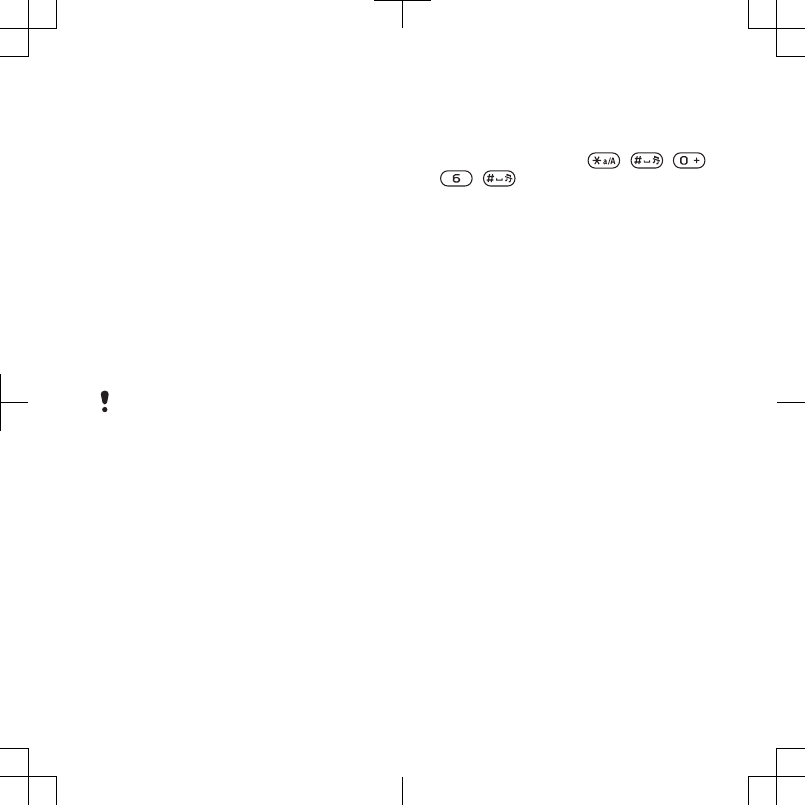
To unlock the phone
•Enter your code and select OK.
To change the phone lock code
1From standby select Menu > Settings >
the General tab > Security > Locks >
Phone protection > Change code.
2Enter the old code and select OK.
3Enter the new code and select OK.
4Repeat the code and select OK.
Keypad lock
You can set this lock to avoid
accidental dialling. Incoming calls can
be answered without unlocking the
keypad.
Calls to the international emergency
number 112 can still be made.
To use the automatic keylock
1From standby select Menu > Settings >
the General tab > Security > Automatic
keylock.
2Select an option.
To unlock the keypad manually
•From standby press any key and select
Unlock > OK.
IMEI number
To view your IMEI number
•From standby press , , ,
, .
More features 67

Troubleshooting
Some problems will require you to call
your network operator.
For more support go to
www.sonyericsson.com/support.
Common questions
I have problems with memory
capacity or the phone is working
slowly
Restart your phone every day to free
memory or do a Master reset.
Master reset
If you select Reset settings, the
changes that you have made to
settings will be deleted.
If you select Reset all, your settings and
content, such as contacts, messages,
pictures, sounds and downloaded
games, will be deleted. You may also
lose content that was in the phone at
purchase.
To reset the phone
1From standby select Menu > Settings >
the General tab > Master reset.
2Select an option.
3Follow the instructions that appear.
I cannot charge the phone or battery
capacity is low
The charger is not properly connected
or the battery connection is poor.
Remove the battery and clean the
connectors.
The battery is worn out and needs to be
replaced. See Charging the battery on
page 8.
No battery icon appears when I start
charging the phone
It may take a few minutes before the
battery icon appears on the screen.
Some menu options appear in grey
A service is not activated. Contact your
network operator.
I cannot use Internet-based services
Your subscription does not include
data capability. Settings are missing or
incorrect.
You can download settings by going to
www.sonyericsson.com/support.
I cannot send messages from my
phone
Most messages require a service
centre number to send them. The
number is supplied by your service
68 Troubleshooting

provider and is usually saved on the
SIM card. If the number to your service
centre is not saved on your SIM card,
you must enter the number yourself.
To send most picture messages, you
must set an MMS profile and the
address of your message server. If no
MMS profile or message server exists,
you can receive all the settings
automatically from your network
operator or at
www.sonyericsson.com/support.
To enter a service centre number
1From standby select Menu > Settings >
Connectivity tab > Message settings >
Text message and scroll to Service
centre. The number is shown if it is
saved on the SIM card.
2If there is no number shown, select
Edit.
3Scroll to New ServiceCentre and select
Add.
4Enter the number, including the
international “+” sign and country/
region code.
5Select Save.
To select an MMS profile
1From standby select Menu > Settings >
the Connectivity tab > Message
settings > Picture message.
2Select an existing profile or create a
new one.
To set the message server address
1From standby select Menu > Settings >
the Connectivity tab > Message
settings > Picture message.
2Scroll to a profile and select Options >
Edit.
3Scroll to Message server and select
Edit.
4Enter the address and select OK >
Save.
The phone does not ring or rings too
softly
Make sure that Silent mode has not
been set to On. See To turn off the
ringtone on page 64.
Check the ringtone volume. See To set
the ringtone volume on page 64.
Check the profile. See To select a
profile on page 63.
Check the divert call options. See To
divert calls on page 41.
The phone cannot be detected by
other devices using Bluetooth
wireless technology
You have not turned the Bluetooth
function on. Make sure that the visibility
Troubleshooting 69
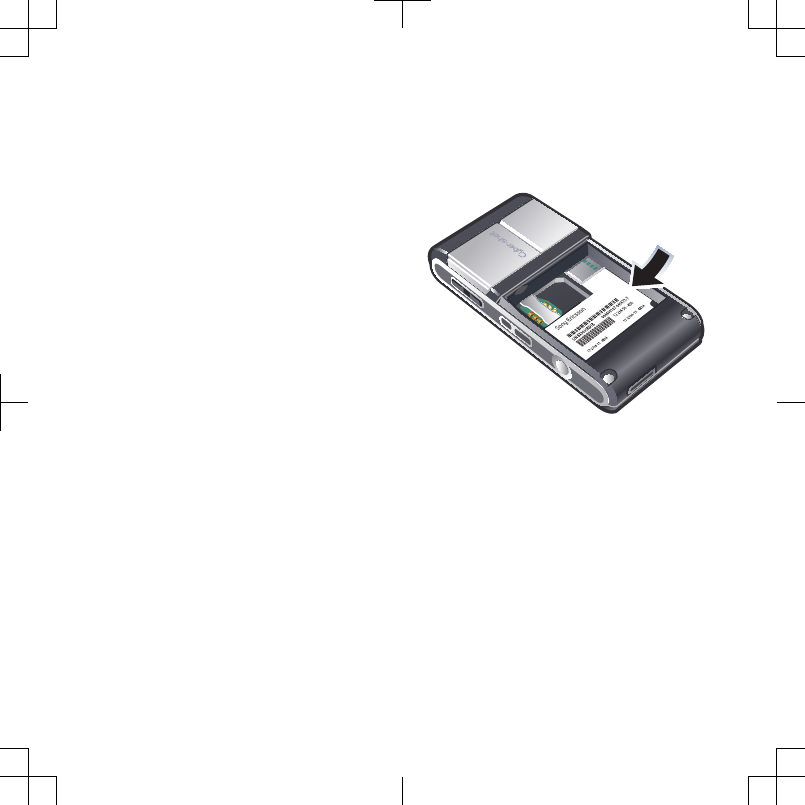
is set to show phone. See To turn on
the Bluetooth function on page 32.
I cannot synchronise or transfer
content between my phone and my
computer, when using the USB cable.
The cable or software that came with
your phone has not been properly
installed. Go to
www.sonyericsson.com/support to
read Feature guides which contain
detailed installation instructions and
troubleshooting guides.
I have forgotten my code memo
passcode
If you forget your passcode, you must
reset the code memo. This means that
all entries in the code memo are
deleted. The next time you enter the
code memo, you must proceed as if
you are opening it for the first time.
To reset code memo
1From standby select Menu > Organiser
> Code memo.
2Enter an incorrect passcode 3 times.
3Reset Code memo and delete all
items? appears.
4Select Yes.
Where can I find the regulatory
information such as my IMEI number
if I cannot turn on my phone?
Error messages
Insert SIM
There is no SIM card in your phone or
you may have inserted it incorrectly.
See Charging the battery on page 8.
The SIM card connectors need
cleaning. If the card is damaged,
contact your network operator.
70 Troubleshooting

Insert correct SIM card
Your phone is set to work only with
certain SIM cards. Check if you are
using the correct operator SIM card.
Wrong PIN/Wrong PIN2
You have entered your PIN or PIN2
incorrectly.
Enter the correct PIN or PIN2 and
select Yes. See To insert the SIM card
on page 6.
PIN blocked/PIN2 blocked
You have entered your PIN or PIN2
code incorrectly three times in a row.
To unblock, see SIM card lock on
page 66.
Codes do not match
Codes that you have entered do not
match. When you want to change a
security code, for example your PIN,
you have to confirm the new code. See
SIM card lock on page 66.
No netw. coverage
Your phone is in flight mode. See Flight
mode on page 60.
Your phone is not receiving any
network signal, or the received signal is
too weak. Contact your network
operator and make sure that the
network has coverage where you are.
The SIM card is not working properly.
Insert your SIM card in another phone.
If this works, it is probably your phone
that is causing the problem. Please
contact the nearest Sony Ericsson
service location.
Emerg. calls only
You are within range of a network, but
you are not allowed to use it. However,
in an emergency, some network
operators allow you to call the
international emergency number 112.
See Emergency calls on page 36.
PUK blocked. Contact operator.
You entered your personal unblocking
key code (PUK) incorrectly 10 times in
a row.
Troubleshooting 71

Important information
Sony Ericsson Consumer Web
site
On www.sonyericsson.com/support there is a
support section where help and tips are only a few
clicks away. Here you will find the latest computer
software updates and tips on how to use your
product more efficiently.
Guidelines for Safe and
Efficient Use
Please follow these guidelines. Failure to do so
might entail a potential health risk or product
malfunction. If in doubt as to its proper function,
have the product checked by a certified service
partner before charging or using it.
Recommendations for care and safe
use of our products
•Handle with care and keep in a clean and dust-
free place.
•Warning! May explode if disposed of in fire.
•Do not expose your product to liquid or moisture
or excess humidity.
•Do not expose to extreme temperatures. Do not
expose the battery to temperatures above
+60°C(+140°F).
•Do not expose to flames or lit tobacco products.
•Do not drop, throw or try to bend your product.
•Do not paint or attempt to disassemble or modify
your product. Only Sony Ericsson authorised
personnel should perform service.
•Please consult medical staff and refer to the
instruction provided by medical equipment
manufacturer before you use the phone near
pacemakers or other medical equipment, device
or in a hospital.
•Discontinue use of electronic devices or disable
the radio transmitting functionality of the device
where required or requested to do so.
•Do not use the phone in potentially explosive
environment, such as gas station, oil depot,
chemical factory and other flammable and
explosive areas.
•Do not place your product or install wireless
equipment in the area above an air bag in your
car.
•Caution: Cracked or broken displays may create
sharp edges or splinters that could be harmful
upon contact.
•Do not use your Bluetooth Headset in positions
where it is uncomfortable or will be subject to
pressure.
Children
Warning! Keep out of the reach of children. Do not
allow children to play with mobile phones or
accessories. They could hurt themselves or others.
Products may contain small parts that could
become detached and create a choking hazard.
Power supply (Charger)
Connect the charger to power sources as marked on
the product. Do not use outdoors or in damp areas.
Do not alter or subject the cord to damage or stress.
Unplug the unit before cleaning it. Never alter the
plug. If it does not fit into the outlet, have a proper
outlet installed by an electrician. When power supply
is connected there is a small drain of power. To avoid
this small energy waste, disconnect the power
supply when the product is fully charged. Use of
charging devices that are not Sony Ericsson
branded may impose increased safety risks.
72 Important information

Battery
New or idle batteries can have short-term reduced
capacity. Fully charge the battery before initial use.
Use for the intended purpose only. Charge the
battery in temperatures between +5°C (+41°F) and
+45°C (+113°F). Do not put the battery into your
mouth. Do not let the battery contacts touch another
metal object. Turn off the product before removing
the battery. Performance depends on temperatures,
signal strength, usage patterns, features selected
and voice or data transmissions. Only
Sony Ericsson service partners should remove or
replace built-in batteries. Use of batteries that are
not Sony Ericsson branded may pose increased
safety risks. Replace the battery only with another
Sony Ericsson battery that has been qualified with
the product per the standard IEEE-1725. Use of an
unqualified battery may present a risk of fire,
explosion, leakage or other hazard.
Note: The environmental protection period (EPUP) of
a battery is 5 years.
5
Personal medical devices
Mobile phones may affect implanted medical
equipment. Reduce risk of interference by keeping
a minimum distance of 15 cm(6 inches) between the
phone and the device. Use the phone at your right
ear. Do not carry the phone in your breast pocket.
Turn off the phone if you suspect interference. For
all medical devices, consult a physician and the
manufacturer.
Driving
Some vehicle manufacturers forbid the use of
phones in their vehicles unless a handsfree kit with
an external antenna supports the installation. Check
with your vehicle manufacturer's representative to
be sure that your mobile phone or Bluetooth
handsfree will not affect the electronic systems in
your vehicle. Full attention should be given to driving
at all times and local laws and regulations restricting
the use of wireless devices while driving must be
observed.
GPS/Location based functions
Some products provide GPS/Location based
functions. Location determining functionality is
provided “As is” and “With all faults”.
Sony Ericsson does not make any representation or
warranty as to the accuracy of such location
information.
Use of location-based information by the device
may not be uninterrupted or error free and may
additionally be dependent on network service
availability. Please note that functionality may be
reduced or prevented in certain environments such
as building interiors or areas adjacent to buildings.
Caution: Do not use GPS functionality in a manner
which causes distraction from driving.
Emergency calls
Calls cannot be guaranteed under all conditions.
Never rely solely upon mobile phones for essential
communications. Calls may not be possible in all
areas, on all networks, or when certain network
services and/or phone features are used.
Antenna
Use of antenna devices not marketed by
Sony Ericsson could damage your phone, reduce
performance, and produce SAR levels above the
established limits. Do not cover the antenna with
your hand as this affects call quality, power levels
and can shorten talk and standby times.
Radio frequency (RF) exposure and
Specific Absorption Rate (SAR)
When your phone or Bluetooth handsfree is turned
on, it emits low levels of radio frequency energy.
Important information 73

International safety guidelines have been developed
through periodic and thorough evaluation of
scientific studies. These guidelines establish
permitted levels of radio wave exposure. The
guidelines include a safety margin designed to
assure the safety of all persons and to account for
any variations in measurements.
Specific Absorption Rate (SAR) is used to measure
radio frequency energy absorbed by the body when
using a mobile phone. The SAR value is determined
at the highest certified power level in laboratory
conditions, but because the phone is designed to
use the minimum power necessary to access the
chosen network, the actual SAR level can be well
below this value. There is no proof of difference in
safety based on difference in SAR value.
Products with radio transmitters sold in the US must
be certified by the Federal Communications
Commission (FCC). When required, tests are
performed when the phone is placed at the ear and
when worn on the body. For body-worn operation,
the phone has been tested when positioned a
minimum of 15 mm from the body without any metal
parts in the vicinity of the phone or when properly
used with an appropriate Sony Ericsson accessory
and worn on the body.
For more information about SAR and radio
frequency exposure go to:
www.sonyericsson.com/cn.
Flight mode
Bluetooth and WLAN functionality, if available in
your device, can be enabled in Flight mode but may
be prohibited onboard aircraft or in other areas
where radio transmissions are prohibited. In such
environments, please seek proper authorization
before enabling Bluetooth or WLAN functionality
even in Flight mode.
Malware
Malware (short for malicious software) is software
that can harm your mobile phone or other
computers. Malware or harmful applications can
include viruses, worms, spyware, and other
unwanted programs. While your device does employ
security measures to resist such efforts,
Sony Ericsson does not warrant or represent that
your device will be impervious to introduction of
malware. You can however reduce the risk of
malware attacks by using care when downloading
content or accepting applications, refraining from
opening or responding to messages from unknown
sources, using trustworthy services to access the
Internet, and only downloading content to your
mobile phone from known, reliable sources.
Accessories
Use only Sony Ericsson branded original
accessories and certified service partners.
Sony Ericsson does not test third-party accessories.
Accessories may influence RF Exposure, radio
performance, sound loudness, electric safety and
other areas. Third-party accessories and parts may
pose a risk to your health or safety or decrease
performance.
Disposal of old electrical and
electronic equipment
Electronic equipment and batteries should not be
included as household waste but should be left at an
appropriate collection point for recycling. This helps
prevent potential negative consequences for the
environment and human health. Check local
regulations by contacting your local city office, your
household waste disposal service, the shop where
you purchased the product or calling a
Sony Ericsson Call Center.
74 Important information
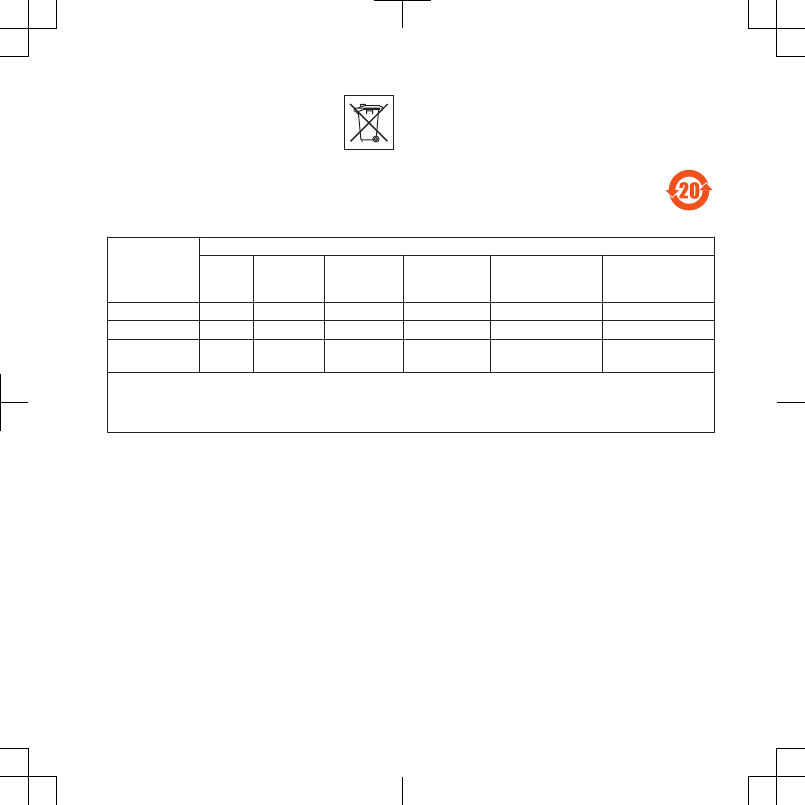
Disposing of the battery
Check local regulations or call a
Sony Ericsson Call Center for information. Never use
municipal waste.
Declaration of substances
When the product is operated under the conditions in the product manual, the environmental
protection period (EPUP) is 20 years.
Part Name Toxic or hazardous substances
Lead (Pb) Mercury (Hg) Cadmium (Cd)Hexavalent
chromium
(Cr6+)
Polybrominated
biphenyls (PBB) Polybrominated
diphenyl ethers
(PBDE)
Phone X 0 0 0 0 0
Battery X 0 0 0 0 0
Accessories and
chargers X 0 0 0 0 0
0: Indicates that this toxic or hazardous substance contained in all of the homogeneous materials for this part is
below the limit requirement in SJ/T 11363-2006. X: Indicates that this toxic or hazardous substance contained in
at least one of the homogeneous materials used for this part is above the limit requirement in SJ/T 11363-2006.
(Currently there are no alternative technologies available.)
Memory card
If your product comes complete with a removable
memory card, it is generally compatible with the
handset purchased but may not be compatible with
other devices or the capabilities of their memory
cards. Check other devices for compatibility before
purchase or use. If your product is equipped with a
memory card reader, check memory card
compatibility before purchase or use.
Memory cards are generally formatted prior to
shipping. To reformat the memory card, use a
compatible device. Do not use the standard
operating system format when formatting the
memory card on a PC. For details, refer to the
operating instructions of the device or contact
customer support.
Warning!
If your device requires an adapter for insertion into
the handset or another device, do not insert the card
directly without the required adapter.
Precautions on Memory Card Use
•Do not expose the memory card to moisture.
•Do not touch terminal connections with your
hand or any metal object.
•Do not strike, bend, or drop the memory card.
Important information 75

•Do not attempt to disassemble or modify the
memory card.
•Do not use or store the memory card in humid or
corrosive locations or in excessive heat such as
a closed car in summer, in direct sunlight or near
a heater, etc.
•Do not press or bend the end of the memory card
adapter with excessive force.
•Do not let dirt, dust, or foreign objects get into the
insert port of any memory card adapter.
•Check you have inserted the memory card
correctly.
•Insert the memory card as far as it will go into any
memory card adapter needed. The memory card
may not operate properly unless fully inserted.
•We recommend that you make a backup copy of
important data. We are not responsible for any
loss or damage to content you store on the
memory card.
•Recorded data may be damaged or lost when
you remove the memory card or memory card
adapter, turn off the power while formatting,
reading or writing data, or use the memory card
in locations subject to static electricity or high
electrical field emissions.
Protection of personal information
Erase personal data before disposing of the product.
To delete data, perform a master reset. Deleting data
from the phone memory does not ensure that it
cannot be recovered. Sony Ericsson does not
warrant against recovery of information and does
not assume responsibility for disclosure of any
information even after a master reset.
Loudness warning!
Avoid volume levels that may be harmful to your
hearing.
End User License Agreement
Software delivered with this device and its media is
owned by Sony Ericsson Mobile Communications
AB, and/or its affiliated companies and its suppliers
and licensors.
Sony Ericsson grants you a non-exclusive limited
license to use the Software solely in conjunction with
the Device on which it is installed or delivered.
Ownership of the Software is not sold, transferred or
otherwise conveyed.
Do not use any means to discover the source code
or any component of the Software, reproduce and
distribute the Software, or modify the Software. You
are entitled to transfer rights and obligations to the
Software to a third party, solely together with the
Device with which you received the Software,
provided the third party agrees in writing to be
bound by the terms of this License.
This license exists throughout the useful life of this
Device. It can be terminated by transferring your
rights to the Device to a third party in writing.
Failure to comply with any of these terms and
conditions will terminate the license immediately.
Sony Ericsson and its third party suppliers and
licensors retain all rights, title and interest in and to
the Software. Sony Ericsson, and, to the extent that
the Software contains material or code of a third
party, such third party, shall be entitled third party
beneficiaries of these terms.
This license is governed by the laws of Sweden.
When applicable, the foregoing applies to statutory
consumer rights.
In the event Software accompanying or provided in
conjunction with your device is provided with
additional terms and conditions, such provisions
shall also govern your possession and usage of the
Software.
76 Important information

Limited Warranty
Sony Ericsson Mobile Communications AB,
SE-221 88 Lund, Sweden, (Sony Ericsson) or its
local affiliated company, provides this Limited
Warranty for your mobile phone, original accessory
delivered with your mobile phone, and/or your
mobile computing product (hereinafter referred to as
“Product”).
Should your Product need warranty service, please
return it to the dealer from whom it was purchased,
or contact your local Sony Ericsson Call Center
(national rates may apply) or visit
www.sonyericsson.com/cn to get further
information.
What we will do
If, during the warranty period, this Product fails to
operate under normal use and service, due to
defects in design, materials or workmanship,
Sony Ericsson authorized distributors or service
partners, in the country/region* where you
purchased the Product, will, at their option, either
repair or replace the Product in accordance with the
terms and conditions stipulated herein.
Sony Ericsson and its service partners reserve the
right to charge a handling fee if a returned Product
is found not to be under warranty according to the
conditions below.
Please note that some of your personal settings,
downloads and other information may be lost when
your Sony Ericsson Product is repaired or replaced.
At present Sony Ericsson may be prevented by
applicable law, other regulation or technical
restrictions from making a backup copy of certain
downloads. Sony Ericsson does not take any
responsibility for any lost information of any kind and
will not reimburse you for any such loss. You should
always make backup copies of all the information
stored on your Sony Ericsson Product such as
downloads, calendar and contacts before handing
in your Sony Ericsson Product for repair or
replacement.
Conditions
1. The warranty is valid only if the original proof of
purchase issued to the original purchaser by a
Sony Ericsson authorised dealer specifying the date
of purchase and serial number*, for this Product, is
presented with the Product to be repaired or
replaced. Sony Ericsson reserves the right to refuse
warranty service if this information has been
removed or changed after the original purchase of
the Product from the dealer.
2. If Sony Ericsson repairs or replaces the Product, the
repaired or replaced Product shall be warranted for
the remaining time of the original warranty period or
for thirty (30) days from the date of repair, whichever
is longer. Repair or replacement may involve the use
of functionally equivalent reconditioned units.
Replaced parts or components will become the
property of Sony Ericsson.
3. This warranty does not cover any failure of the
Product due to normal wear and tear, or due to
misuse, including, but not limited to, use in other
than the normal and customary manner, in
accordance with the Sony Ericsson instructions for
use and maintenance of the Product. Nor does this
warranty cover any failure of the Product due to
accident, software or hardware modification or
adjustment, acts of God or damage resulting from
liquid.
A rechargeable battery can be charged and
discharged hundreds of times. However, it will
eventually wear out – this is not a defect. When the
talk-time or standby time is noticeably shorter, it is
time to replace the battery. Sony Ericsson
recommends that you use only batteries and
chargers approved by Sony Ericsson.
Minor variations in display brightness and colour
may occur between phones. There may be tiny
bright or dark dots on the display. These are called
Important information 77

defective pixels and occur when individual dots have
malfunctioned and can not be adjusted. Two
defective pixels are deemed acceptable.
Minor variations in the appearance of the camera
image may occur between phones. This is not
uncommon in digital cameras and does not mean
that the camera is defective in any way.
4. Since the cellular system on which the Product is to
operate is provided by a carrier independent from
Sony Ericsson, Sony Ericsson will not be responsible
for the operation, availability, coverage, services or
range of that system.
5. This warranty does not cover Product failures
caused by installations, modifications, or repair or
opening of the Product performed by a non-
Sony Ericsson authorised person.
6. The warranty does not cover Product failures which
have been caused by use of accessories or other
peripheral devices which are not Sony Ericsson
branded original accessories intended for use with
the Product.
7. Tampering with any of the seals on the Product will
void the warranty.
8. THERE ARE NO EXPRESS WARRANTIES,
WHETHER WRITTEN OR ORAL, OTHER THAN THIS
PRINTED LIMITED WARRANTY. ALL IMPLIED
WARRANTIES, INCLUDING WITHOUT LIMITATION
THE IMPLIED WARRANTIES OF
MERCHANTABILITY OR FITNESS FOR A
PARTICULAR PURPOSE, ARE LIMITED TO THE
DURATION OF THIS LIMITED WARRANTY. IN NO
EVENT SHALL SONY ERICSSON OR ITS
LICENSORS BE LIABLE FOR INCIDENTAL OR
CONSEQUENTIAL DAMAGES OF ANY NATURE
WHATSOEVER, INCLUDING BUT NOT LIMITED TO
LOST PROFITS OR COMMERCIAL LOSS TO THE
FULL EXTENT THOSE DAMAGES CAN BE
DISCLAIMED BY LAW.
Some countries/regions/states do not allow the
exclusion or limitation of incidental or consequential
damages, or limitation of the duration of implied
warranties, so the preceding limitations or
exclusions may not apply to you.
The warranty provided does not affect the
consumer's statutory rights under applicable
legislation in force, nor the consumer’s rights against
the dealer arising from their sales/purchase
contract.
* In some countries/regions additional information is
requested. If so, this is clearly shown on the valid
proof of purchase.
FCC Statement
This device complies with Part 15 of
the FCC rules. Operation is subject
to the following two conditions: (1)
This device may not cause harmful interference, and
(2) This device must accept any interference
received, including interference that may cause
undesired operation.
Any change or modification not expressly approved
by Sony Ericsson may void the user's authority to
operate the equipment.
This equipment has been tested and found to
comply with the limits for a Class B digital device,
pursuant to Part 15 of the FCC Rules. These limits
are designed to provide reasonable protection
against harmful interference in a residential
installation. This equipment generates, uses and can
radiate radio frequency energy and, if not installed
and used in accordance with the instructions, may
cause harmful interference to radio
communications. However, there is no guarantee
that interference will not occur in a particular
installation.
If this equipment does cause harmful interference to
radio or television reception, which can be
determined by turning the equipment off and on, the
user is encouraged to try to correct the interference
by one or more of the following measures:
•Reorient or relocate the receiving antenna.
78 Important information
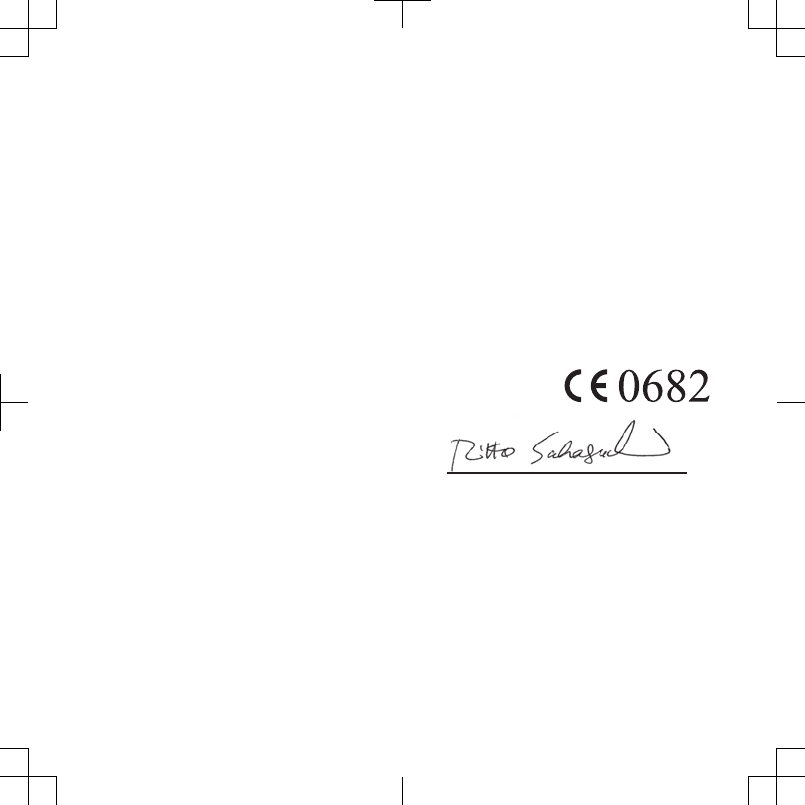
•Increase the separation between the equipment
and receiver.
•Connect the equipment into an outlet on a circuit
different from that to which the receiver is
connected.
•Consult the dealer or an experienced radio/TV
technician for help.
Industry Canada Statement
This device complies with RSS-210 of Industry
Canada.
Operation is subject to the following two conditions:
(1) this device may not cause interference, and (2)
this device must accept any interference, including
interference that may cause undesired operation of
the device.
This Class B digital apparatus complies with
Canadian ICES-003.
Cet appareil numérique de la classe B est conforme
à la norme NMB-003 du Canada.
Declaration of Conformity for
C905c
We, Sony Ericsson Mobile Communications AB of
Nya Vattentornet
SE-221 88 Lund, Sweden
declare under our sole responsibility that our
product
Sony Ericsson type AAC-1052151-BV
and in combination with our accessories, to which
this declaration relates is in conformity with the
appropriate standards EN 301 511:V9.0.2, EN 300
328:V1.7.1, EN 300 440-1:V1.4.1, EN 300
440-2:V1.1.2, EN 301 489-7:V1.3.1, EN 301
489-17:V1.2.1, EN 301 489-3:V1.4.1, EN 60
950-1:2006 following the provisions of, Radio
Equipment and Telecommunication Terminal
Equipment directive 1999/5/EC.
Lund, October
2008
Rikko Sakaguchi,
Head of Creation & Development
We fulfil the requirements of the R&TTE Directive
(1999/5/EC).
Important information 79

Index
A
activity menu ........................................16
alarms ...................................................61
answering service .................................40
applications ..........................................65
appointments .......................................62
assembly ................................................6
audio book ...........................................50
auto rotate ............................................65
B
backing up and restoring .....................33
battery
charging .........................................8
inserting ..........................................6
use and care .................................73
BestPic™ .............................................25
Bluetooth™ wireless technology .........32
bookmarks ...........................................53
business card .......................................39
C
calendar ................................................62
call divert ..............................................41
call list ..................................................36
call numbers in message ......................45
call time ................................................44
caller-specific ringtones .......................38
calls
accepting .....................................43
answering and rejecting ...............36
emergency ...................................36
handling two calls ........................42
international ..................................35
making and receiving ...................35
putting on hold .............................41
recording ......................................53
camera .................................................24
activating ......................................24
overview .......................................24
printing .........................................29
settings .........................................26
code memo ..........................................70
conference calls ...................................42
contacts
adding phone contacts ................37
default contacts ...........................37
groups of ......................................40
costs .......................................................7
D
date ......................................................64
declaration of conformity .....................79
downloading music ..............................51
80 Index

E
email .....................................................46
emergency numbers ............................36
end user license agreement .................76
entering text .........................................18
F
face detection ......................................25
file manager ..........................................29
flight mode ...........................................60
G
games ...................................................65
geo tagging ..........................................27
GPS ......................................................57
groups ..................................................40
H
handsfree .......................................41, 49
Bluetooth™ wireless technology . 33
help .........................................................8
hiding number ......................................44
I
imaging .................................................24
IMEI number .........................................67
instant messaging ................................47
Internet
bookmarks ...................................53
screen orientation ........................54
security and certificates ...............55
settings .........................................68
K
keypad lock ..........................................67
keys ......................................................11
L
language ...............................................17
location services ...................................57
lock
keypad ..........................................67
phone ...........................................66
SIM card .......................................66
M
master reset .........................................68
Media Manager ....................................30
media transfer ......................................31
memory ................................................16
memory card ........................................16
memory status .....................................39
menu overview .....................................13
messages
email .............................................46
text and picture ............................44
voice .............................................46
microphone ..........................................36
MMS See picture messages
music player ...................................49, 50
Index 81

MusicDJ™ ............................................52
my numbers .........................................43
N
navigating menus .................................15
notes ....................................................62
O
online music and video clips ................51
P
pan and zoom, Web pages ..................54
PC Suite ...............................................58
phone memory .....................................16
phone mode .........................................59
phone name .........................................32
phone, turning on ...................................7
photo fix ...............................................26
Photo Mate ...........................................26
PhotoDJ™ ............................................28
photos ..................................................27
editing ..........................................28
geo tagging ..................................27
improving .....................................26
tags ..............................................27
picture messages .................................44
pictures ................................................27
PIN ....................................................7, 66
playlists ................................................50
PlayNow™ ............................................51
podcasts ..............................................56
power saving ........................................33
profiles ..................................................63
PUK ......................................................66
push email ............................................47
R
radio .....................................................52
recording, listen to ...............................53
restricted dialling ..................................43
ringtones ..............................................64
roaming ..................................................7
RSS feeds See Web feeds
S
safety guidelines ...................................72
screen orientation ...........................54, 65
search, on Web pages .........................54
selection keys .......................................15
settings, Internet ..................................68
shortcuts ..............................................15
SIM card
copying to/from ............................38
inserting ..........................................6
lock and unblock ..........................66
SMS See text messages
SOS See emergency numbers
sound recorder .....................................53
speed dialling .......................................40
82 Index

standby ..................................................7
notes ............................................63
synchronising .......................................58
T
T9™ Text Input .....................................18
tagging photos .....................................27
tasks .....................................................63
templates ..............................................45
text messages ......................................44
theme ...................................................64
time ......................................................64
time zone ..............................................64
TrackID™ .............................................51
transfer method
Bluetooth™ wireless technology . 32
USB cable ....................................31
transferring
music ............................................30
photos ..........................................30
sound ...........................................33
turning on/off
Bluetooth™ function ....................32
phone lock ....................................66
SIM lock protection ......................66
U
Update service .....................................60
USB cable ............................................31
V
video editing .........................................28
video player ..........................................52
video recorder ......................................24
VideoDJ™ ............................................28
voice control .........................................41
voice messages ....................................46
voicemail ..............................................40
volume
ear speaker ..................................36
ringtone ........................................64
W
warranty ...............................................77
Web feeds ............................................55
Web pages, history ..............................54
Z
zoom ....................................................25
Index 83